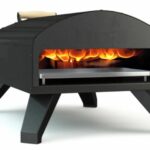The Best Fluffy Pancakes recipe you will fall in love with. Full of tips and tricks to help you make the best pancakes.
Portable Pizza Oven from Gozney
Gozney Roccbox Pizza Oven
The Gozney Roccbox is a dual-fuel oven, but it comes with only the gas burner – the wood burner is sold separately (at $100). The oven is well designed and looks beautiful in its olive green outer casing, made of silicone which also helps prevent the exterior surface from getting hot.
From the body to the individual elements, the unit is sturdy and well-built. The body, legs, and burners are all made from thick 304-grade stainless steel. A dense calcium silicate insulation has also been added between the outer casing and the shell. The cordierite pizza stone is strong and thick (19mm) too. It comes securely fixed in place.
Assembling the Roccbox is easy – you only attach the burner and that’s it. The oven is compact but it takes some effort to carry it around as it’s heavy (44 lbs). Its cooking space is also fairly small – ideal for just 11-inch pizzas. Cleaning it is tricky too as it gets very sooty, even with gas.
The performance is pretty good, though. It gets screaming hot, even hitting over 930°F when using gas. The pre-heat time is slow (45 minutes) but the overall heat retention and distribution are excellent due to the dense insulation and the rolling flame. However, it doesn’t perform well with wood – it takes up to 90 minutes to preheat and the temp only reaches 800°F. Keeping the temp consistent is even more challenging.
We got impressive results when using gas – all pizzas come out cooked perfectly and the cooking time is fairly fast (less than 2 minutes). You can cook pizza after pizza as the oven stays hot. The results with wood weren’t pleasant though as almost all the pizzas were undercooked or burnt.
Overall, the Roccbox is a very capable pizza oven, especially if cooking with gas. It isn’t the cheapest or the lightest but it’s certainly a great value given that it comes with some useful accessories including a built-in thermometer, a pizza peel, a carrying strap, and a hopper tool. It’s also backed by a 5-year warranty once registered after purchase.
Description for this block. Use this space for describing your block. Any text will do. Description for this block. You can use this space for describing your block.
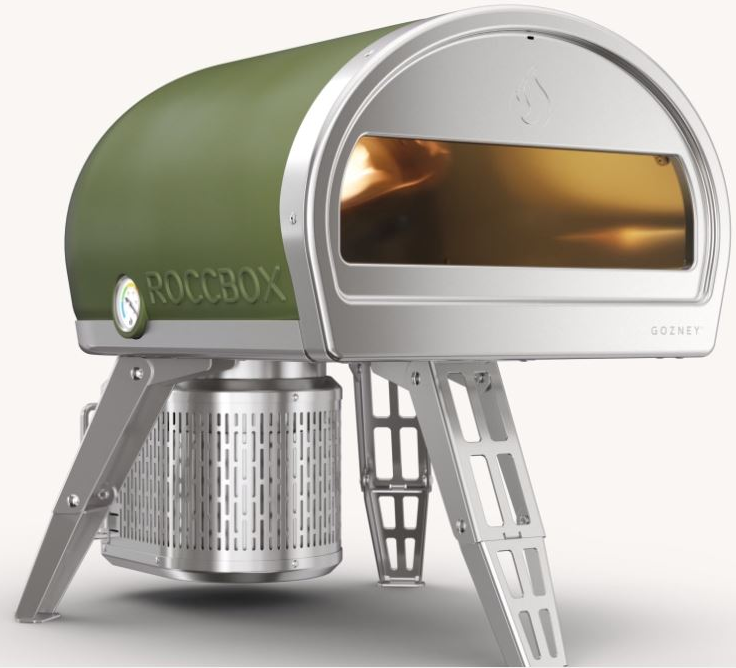
Gozney’s outdoor pizza ovens are usually at par, if not better than those of most top established brands like Ooni. We got their Roccbox model, which at $499, is pricier than most other similar pizza ovens, like the Ooni Koda 12 (which costs $100 less). That extra cost though comes with solid upgrades and features that make it stand out.
To start, the Roccbox can use either gas or wood. It comes with the gas burner, but you can get the wood burner too, for an extra $100. The oven is also available in two colors (olive green or slate gray). We got the green one together with the two burners.
The first thing we liked about it was its dense insulation and thick pizza stone, which allowed it to retain heat very well. The unit also features Gozney’s patented baffle plate technology that creates incredible yellow rolling flames to ensure a nice even top heat.
The build quality was great too, far better than even Ooni pizza ovens. Other highlights we liked included the thick silicone jacket to help prevent accidental burns from touching the outer surface, the built-in thermometer, and the pizza peel.
In general, we were seriously impressed with the quality and performance of the Roccbox. It hits over 932°F temperatures with the gas burner and delivers truly impressive results right from the start. We only had problems when using the wood burner, where we struggled to get to high temperatures and also to keep the heat consistent. The other slight setback was the fact that the oven is heavy even despite its compact design.
Design
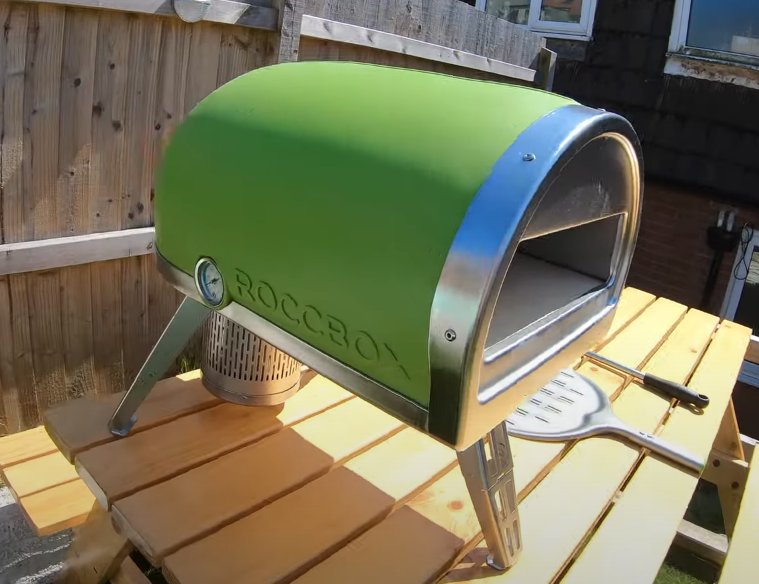
The design of the Roccbox was slightly different from most standard pizza ovens we’ve tested. The main body was almost space-age shaped, not dome-like as the rest. Moreover, the shell was wrapped in matte silicone while the rest of the structure including the legs, burners, and the front and bottom parts were all gleaming steel. It was a very modern-looking oven.
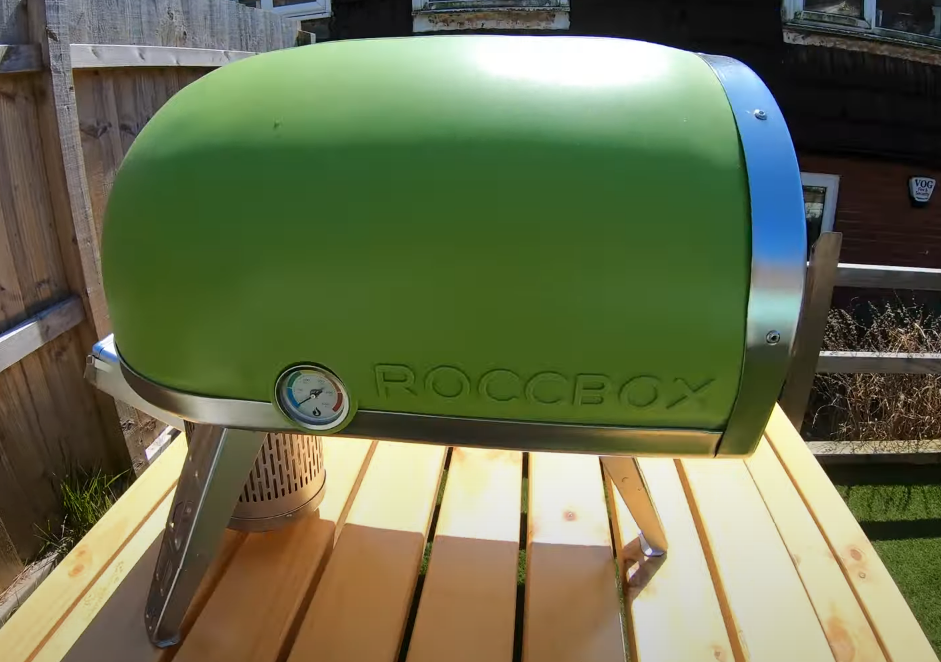
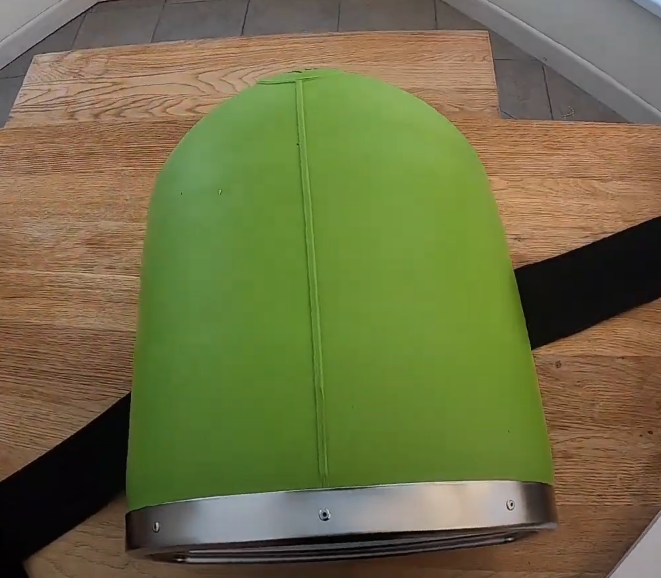
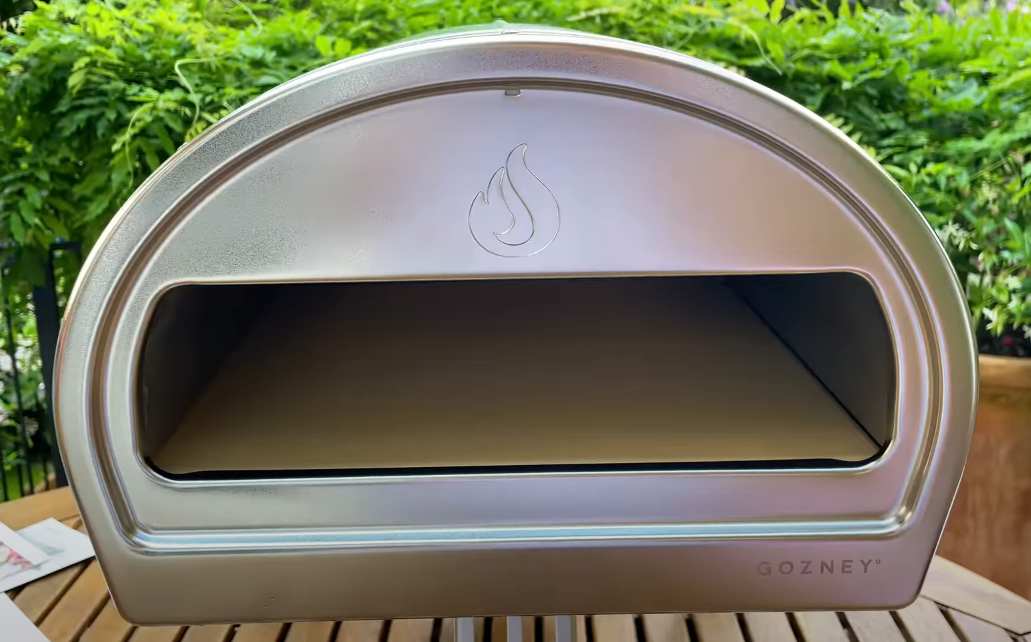
The matter silicone itself comes in an olive green or slate gray color that makes it stands out even more compared to regular steel or black pizza ovens. Even the color-coded thermometer on the side added a bit of style and modern appeal to it despite it being an analog thermometer. It was the first pizza oven that looked cooler on our patio – we got the olive green one and it fit perfectly with the theme of our patio.
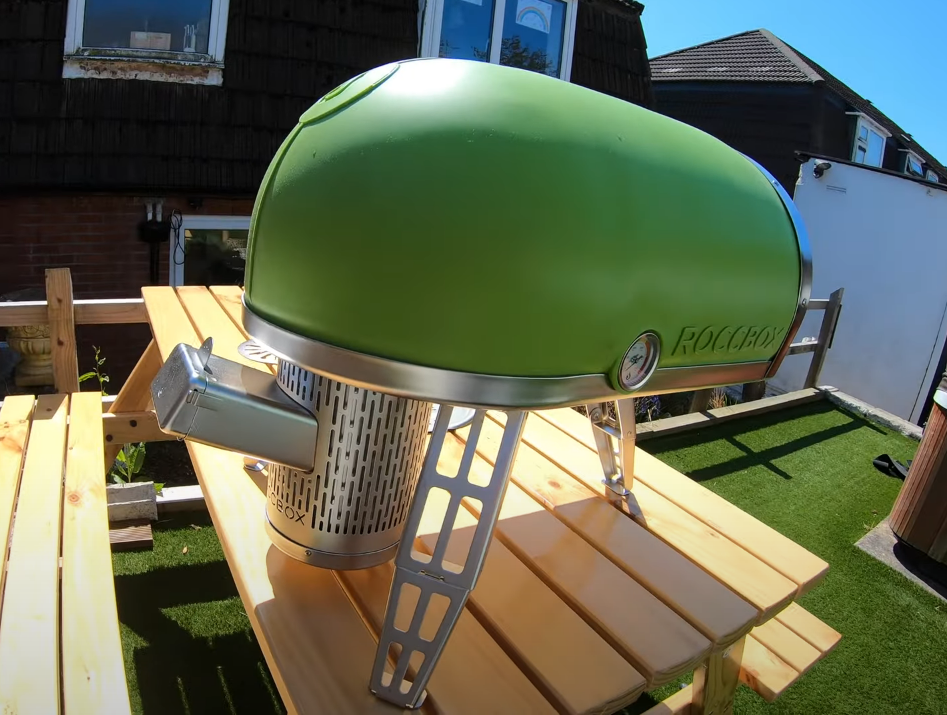
The silicone jacket isn’t just for decoration purposes too. It’s meant to prevent the exterior from getting as hot as the interior of the oven to minimize the risks of burns (more on that later).
The whole unit was generally well-designed. Except for the legs, the entire body was streamlined. There were no sharp edges on its exterior or interior parts. Furthermore, like the Ooni Koda 12, the Roccbox doesn’t come with a chimney and there’s no door too, so you get to see the pizza as it cooks.
Even the peel felt smartly designed – it featured a short grip that’s comfortable to hold, making it quite easy to maneuver and set pizzas in the oven or to remove them.
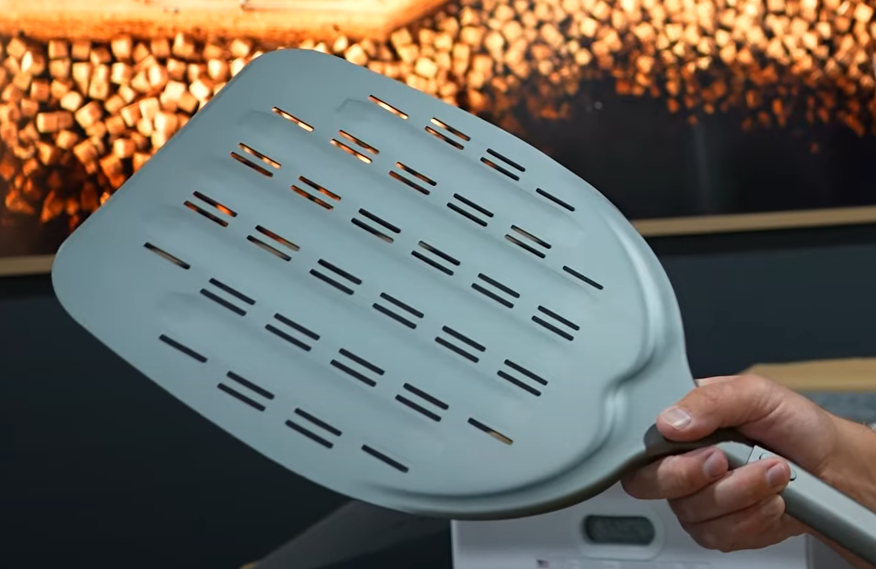
We liked too how tall its legs were. They placed the opening a lot higher compared to Ooni ovens and even other pizza ovens. We didn’t really have to bend down much to launch, check, turn, and remove the pizzas – it may seem a small thing but trust us, it can get pretty tiring after a long while, especially on your lower back.
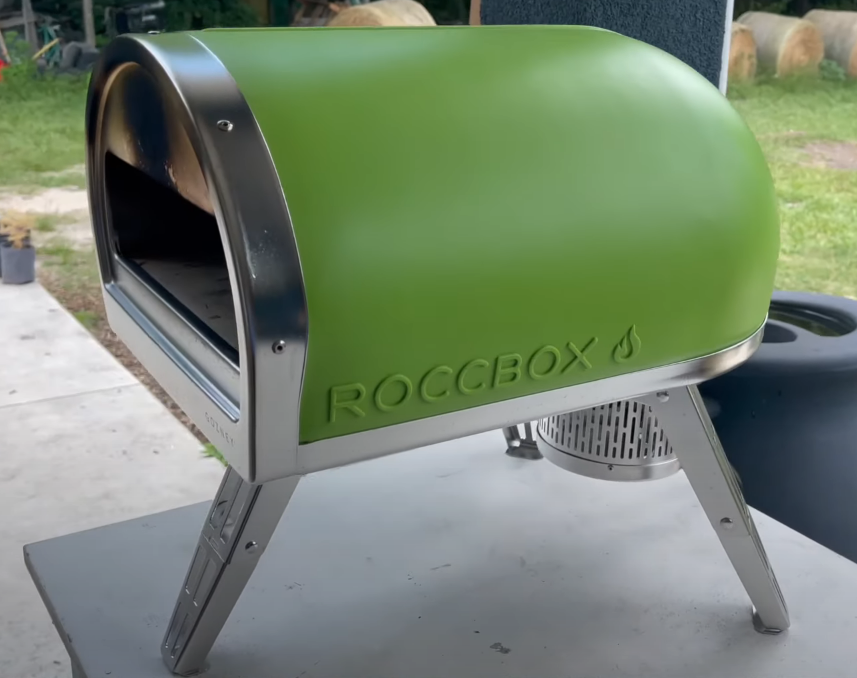
The footprint of this Roccbox oven was also impressively small despite it being fairly tall. It measures 18.5 x 21.2 x 16.1 inches with the legs extended. That’s sufficiently compact for a modestly-sized outdoor patio. The burners are detachable and the tripod legs fold twice into themselves to tuck up snugly against the oven’s body, making it convenient to store and move. You can easily store it in a small shed or basement when you’re done using it without any issues.

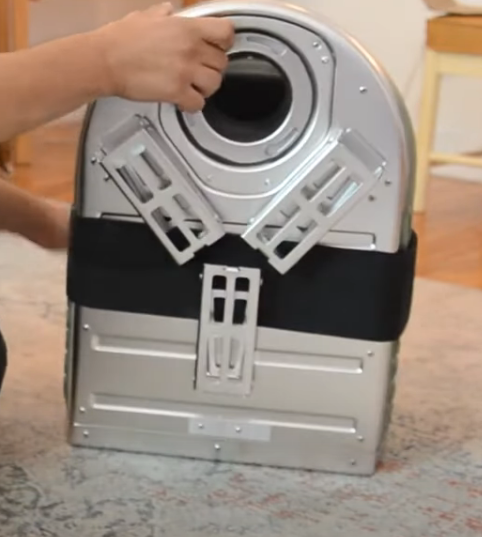
Despite it being compact and designed to be portable, the Roccbox was fairly hefty. It weighs around 44 pounds (20 kg), which is more than the average weight (20 to 30 pounds) of most portable pizza ovens. The weight mostly comes from the pizza stone which is fixed inside it. You can’t remove it. I did manage to carry it alone and put it on a table but it certainly took some effort to do it. It’s not an oven you would want to be taking in and out of the house frequently.
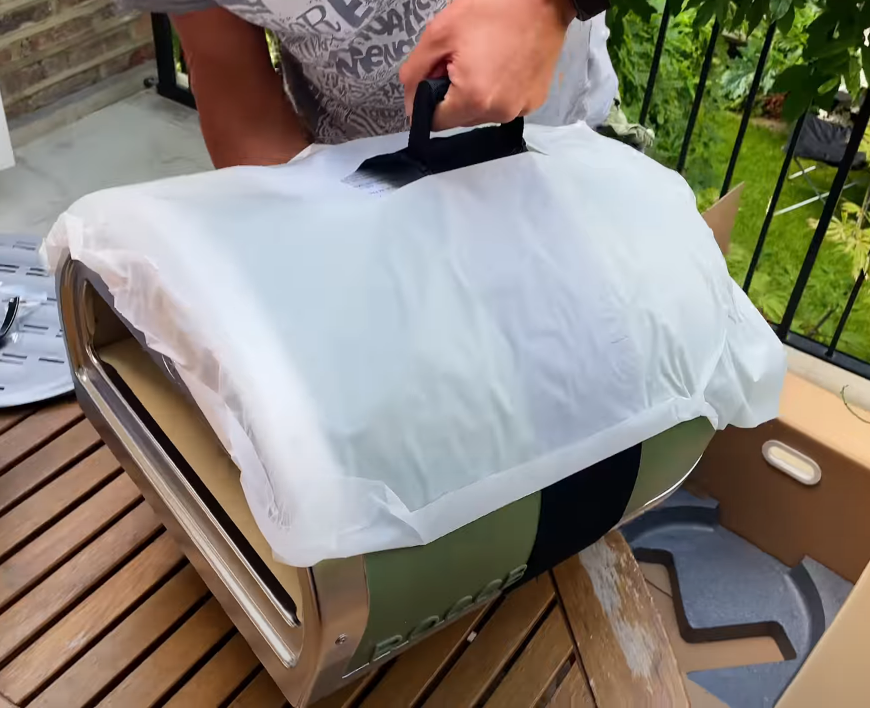
There’s a handy velcro strap with a padded handle provided to make carrying it easier but it only has a single handle. Given how heavy the oven is, you still have to use two hands (one on the handle and one below the oven) to haul it around. So, even with the strap, you may still break a sweat moving the oven around – it helps though, especially when loading the oven into a car if you want to take it to the beach, camp, park, or pretty much anywhere else you like.
Our Score: 9 out of 10
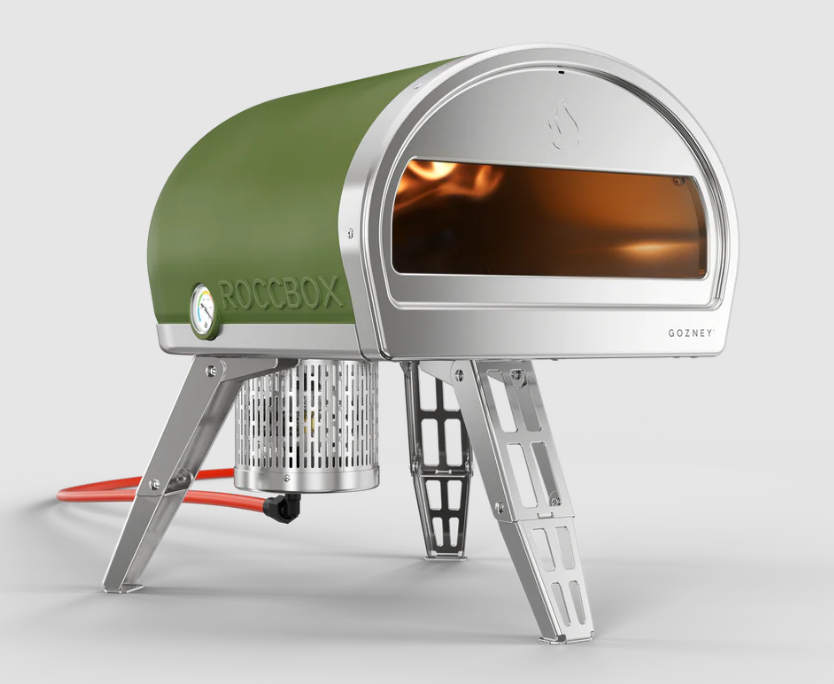
Gozney Roccbox
Build Quality
When we first lifted the Roccbox out of its box, we immediately noticed and felt how hefty and robust it was. From the body to the individual elements, everything was sturdy and well-built.
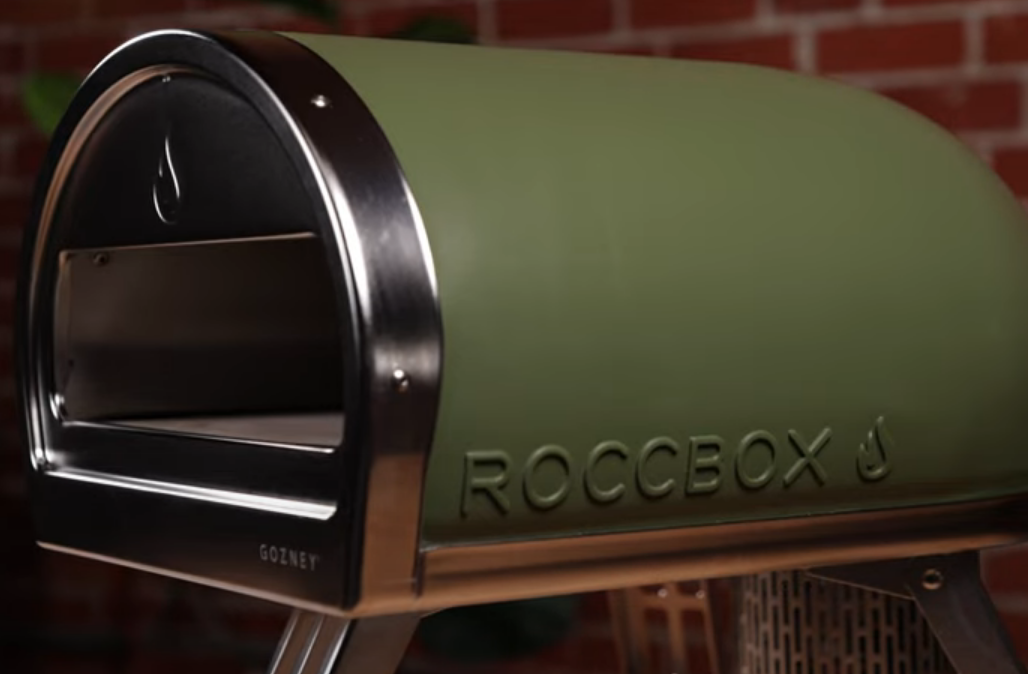
The main body and the legs are made from 304-grade stainless steel. The steel makes up the inner shell and base of the oven body, but there’s also a dense calcium silicate insulation between the outer casing and the shell that goes all the way to the back, where it’s even much thicker as that’s where the flame emanates from. The floor of the oven is thick too, made of a cordierite stone that’s fixed on the stainless steel base.
Gozney went ahead and also enveloped the Roccobox’s body with a fairly thick silicone cover as the outer casing. It had a nice rubberized feel to it and clad three-quarters of the body – up to the back. Only the base and the front parts weren’t covered – the front part is just steel.
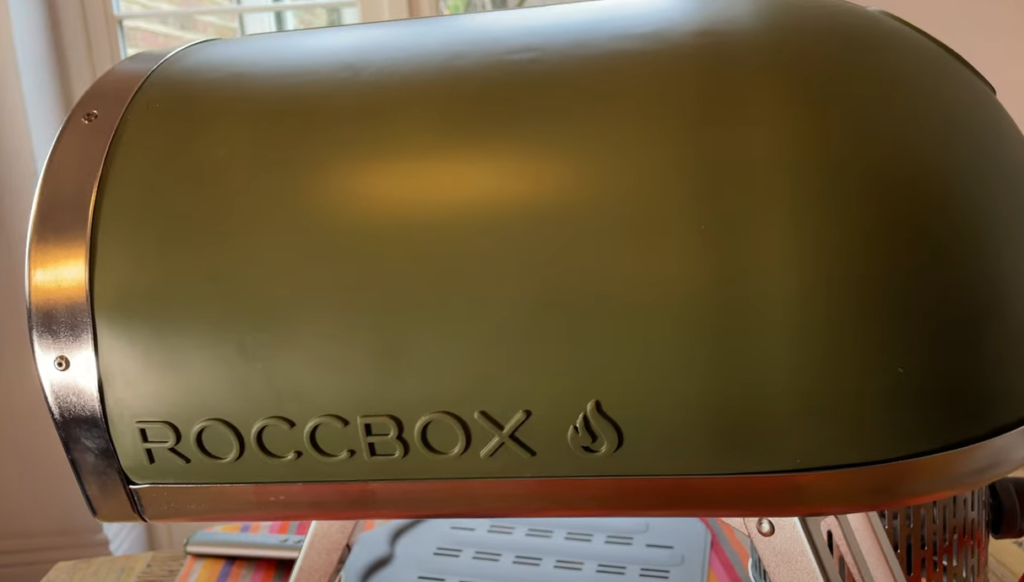
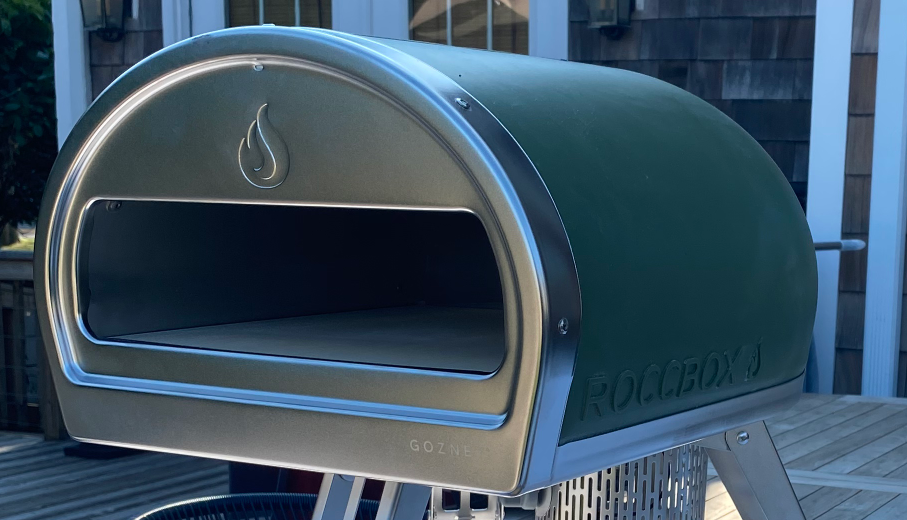
In general, we found the build quality of the Roccbox to be far better than other ovens we’ve tested, including Ooni ovens.
The thick steel legs were very sturdy. The oven always remained solid and stable on them when set on any flat surface. It never wobbled and despite the legs being retractable (fold out twice in a tripod-like configuration), they never seemed like they could fold in easily under pressure.
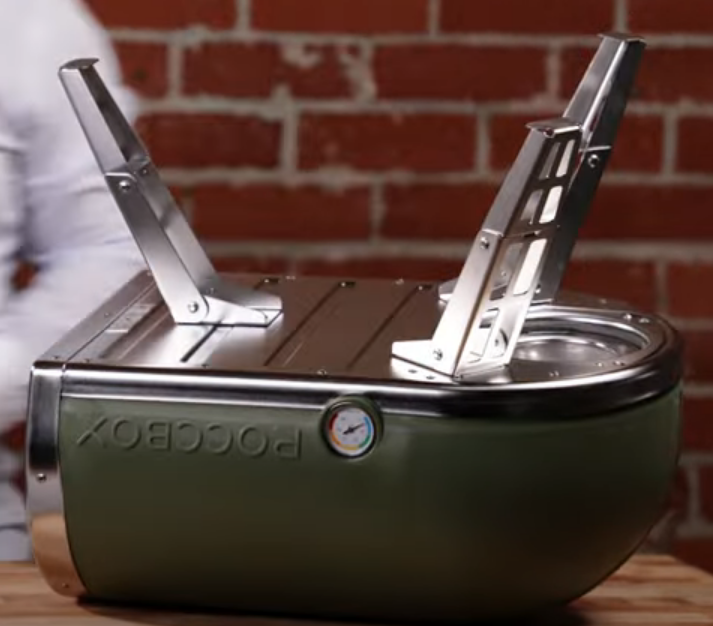
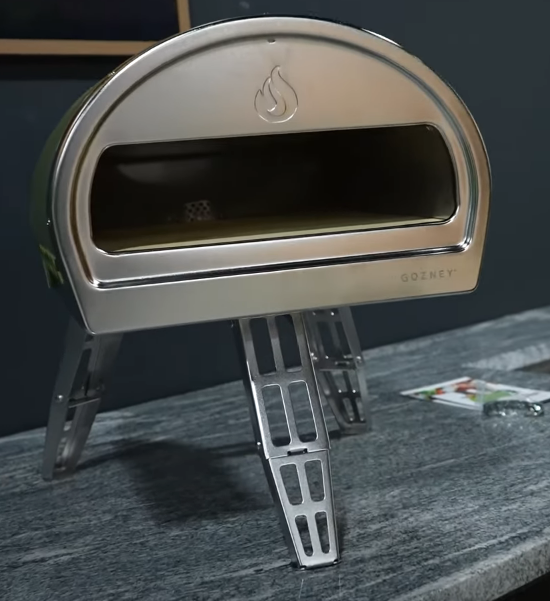
Once folded out, they remain in place. Still, though, it would have been better if we could lock them in place. They are sturdy, but including a decent locking mechanism would give us a greater sense of security.
That said, we did like the quality of the pizza stone. It’s a 19mm-thick cordierite stone. That’s thicker than the 10 to 16-mm thick stones of most pizza ovens. Moreover, the Roccbox stone comes securely fixed in place. You can’t drop it when carrying the oven. It’s a design that makes replacing it difficult but it does help prevent accidental damage from slipping out.
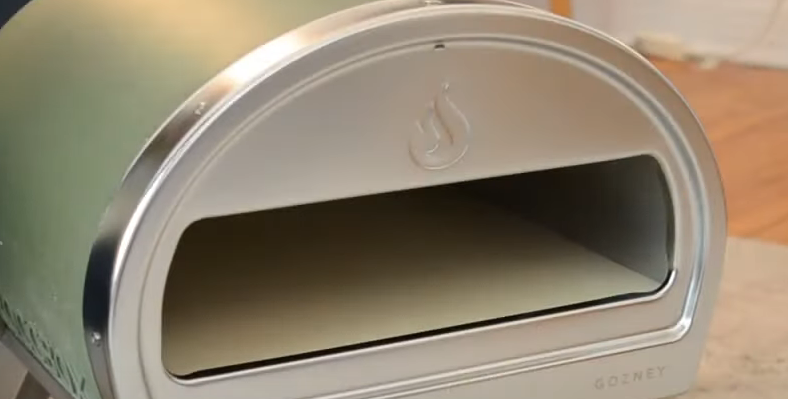
The burners as well as the provided pizza peel were sturdy too and made of stainless steel. The burners, in particular, were pretty strong with a hefty feel in them.
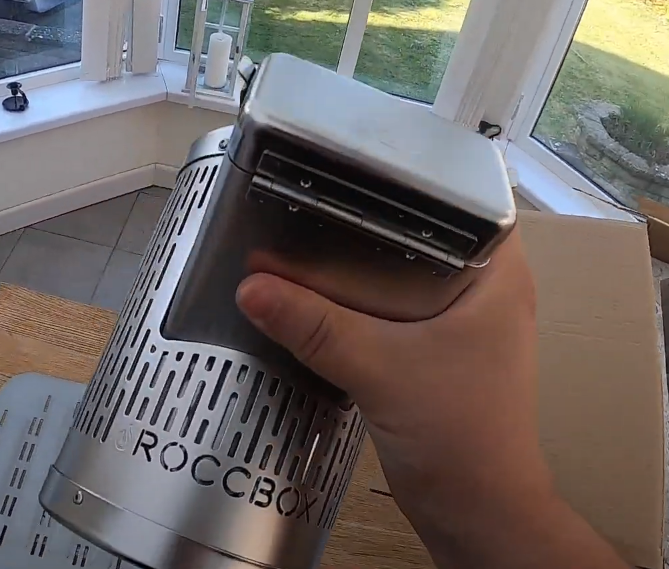
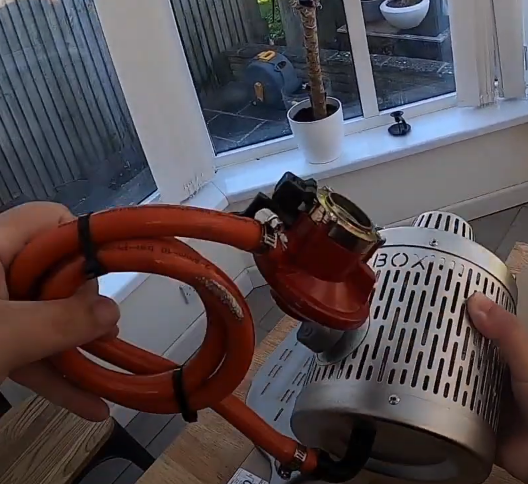
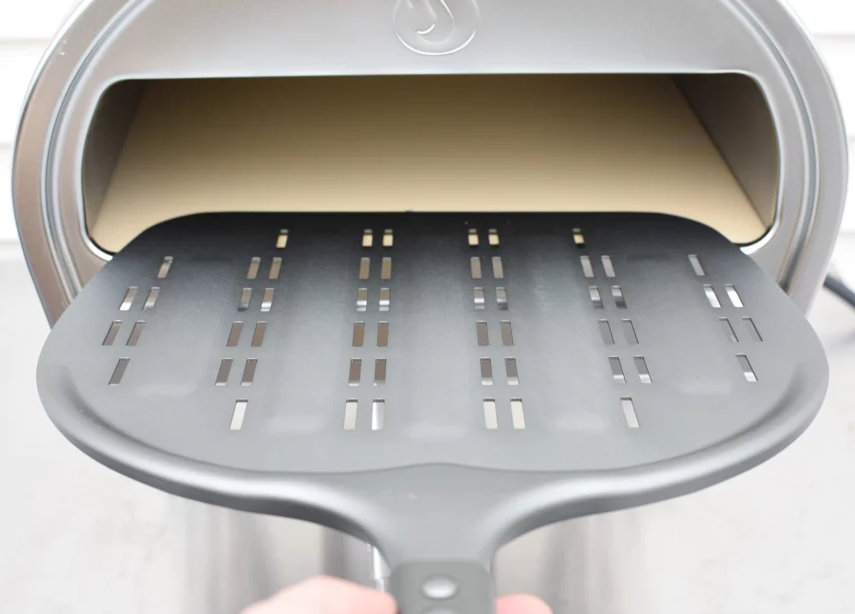
There were generally no shoddy or flimsy elements to this Roccbox oven. Everything about it felt very sturdily made and reassuringly solid – even the included instruction manual was a thick, glossy booklet. Up until the time we finished testing it, we hadn’t noticed any issue with the build. So, it’s an oven you can expect to last a long time.
Our Score: 9 out of 10
Assembly
The Roccbox came in a single large cardboard box complete with handles. It looked like they really put in extra effort to ensure a good first impression because the packaging was pretty impressive. The main large box included another separate box that housed the oven.
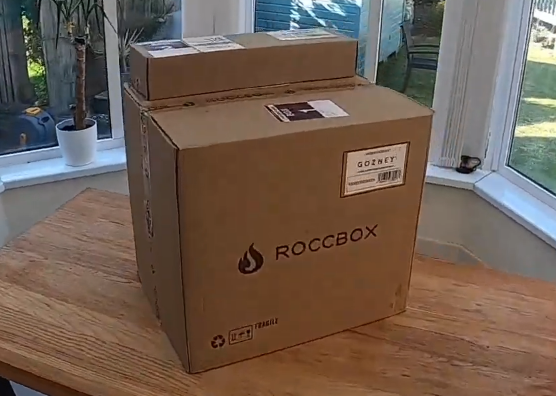
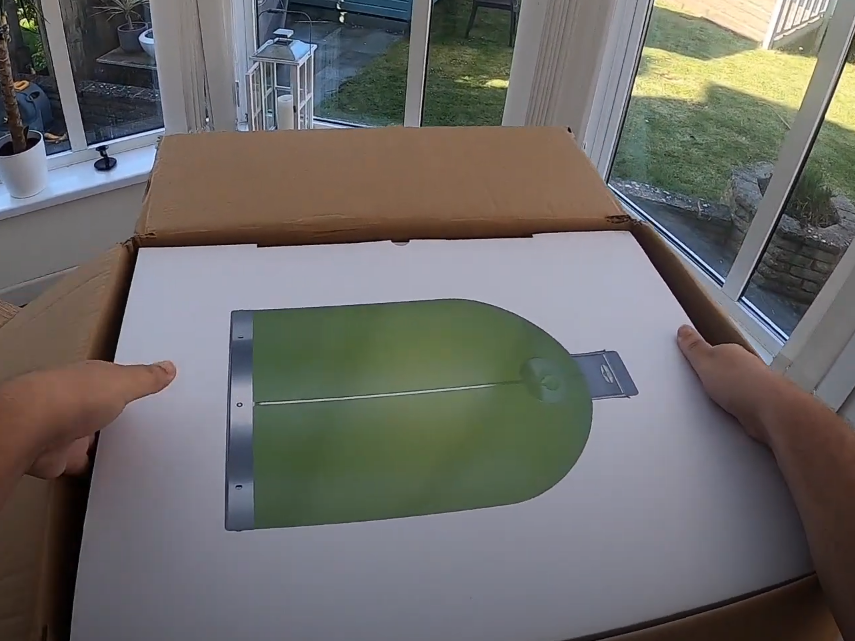
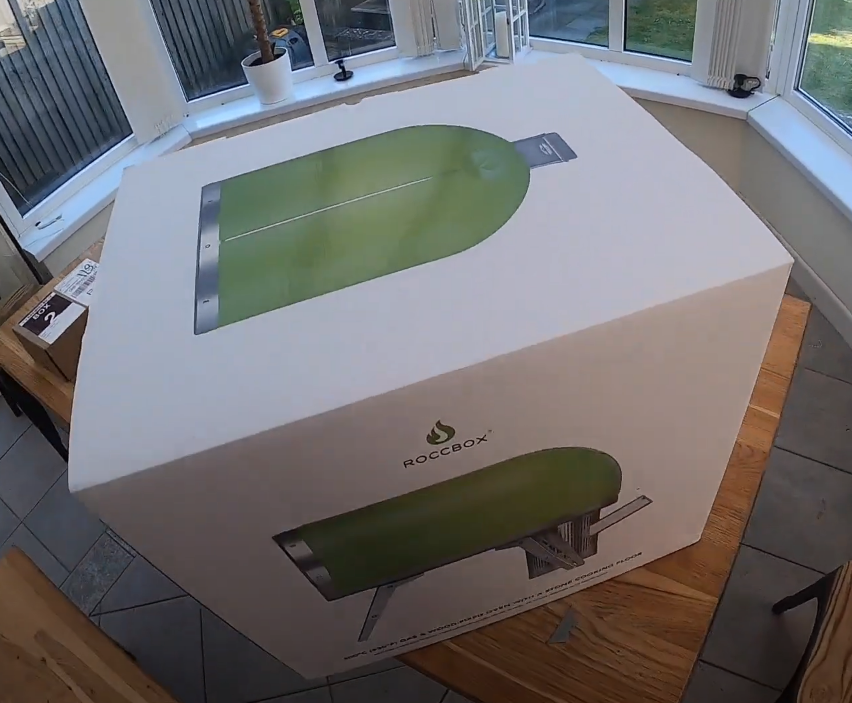
Everything was neatly packaged in the box as we opened it. The first item we found was the pizza peel which was safely tucked into a compartment on a fairly thick styrofoam.
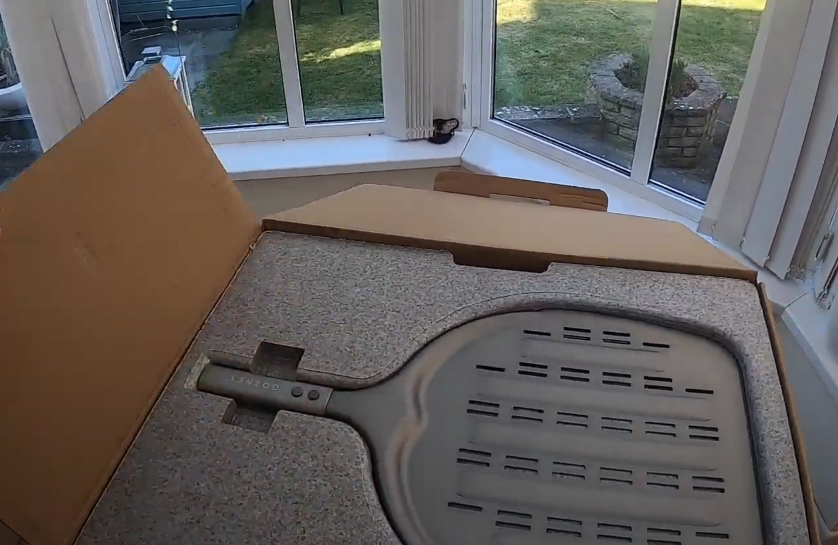
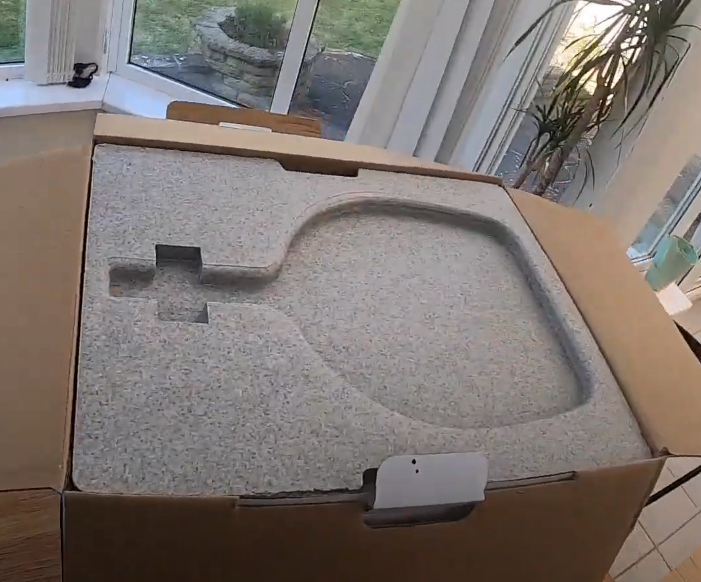
Below it was the wood burner and the gas burner, also safely tucked into compartments on thicker styrofoam. Next to the burners was a bottle opener, tucked in a compartment too.
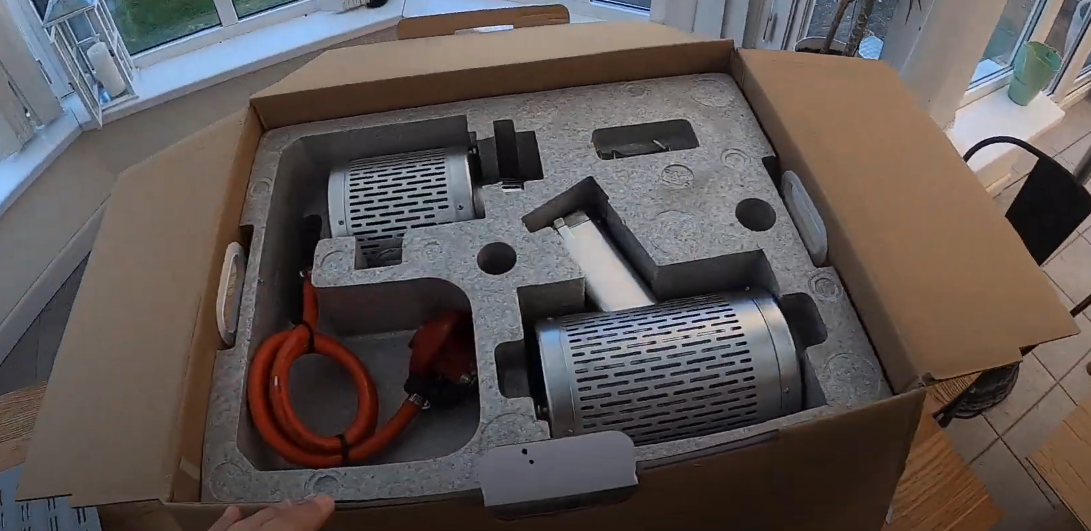
Under them was the oven itself, nestled securely in another thick styrofoam panel. A velcro strap came already wrapped around its body which made it easy to lift it out of the box.
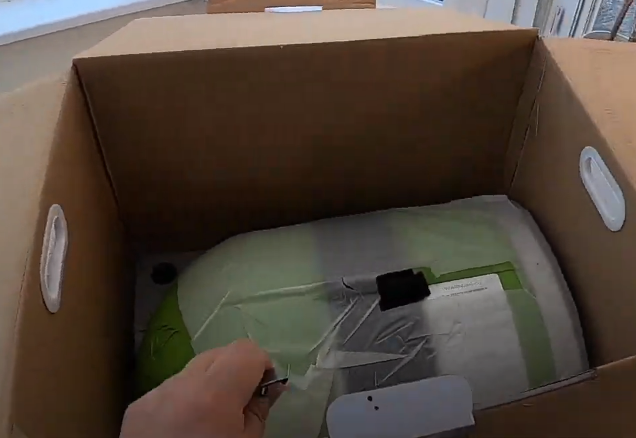
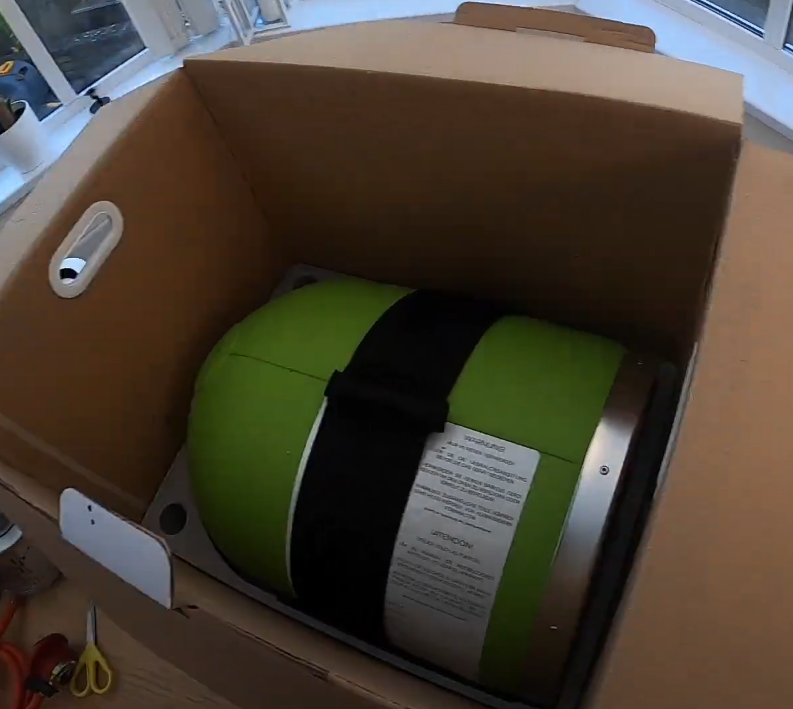
There was certainly no wasted space given how snugly everything was packaged. We got 8 parts out of the box in total, which included the pizza peel, the gas burner (with hose and regulator attached), the wood burner, a bottle opener, the Roccbox oven, a velcro lifting strap, a recipe book, and an instruction manual. So, apart from the fuel itself, you basically get everything needed to get started – we also got a separate small peel as you see below (it’s not included).
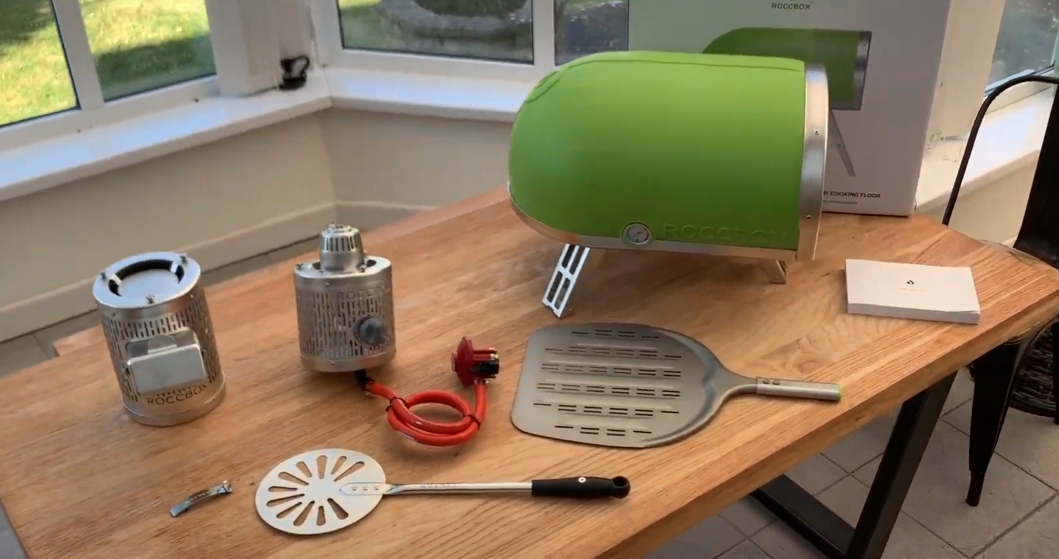
Once unboxed, there’s hardly any assembly needed as the oven comes almost fully assembled. All that’s needed is to attach the burner you want to use to the slot at the back and simply twist it to securely lock it in place- it clicks when it’s locked in place. Detailed instructions and pictures are in the manual but it’s pretty straightforward.
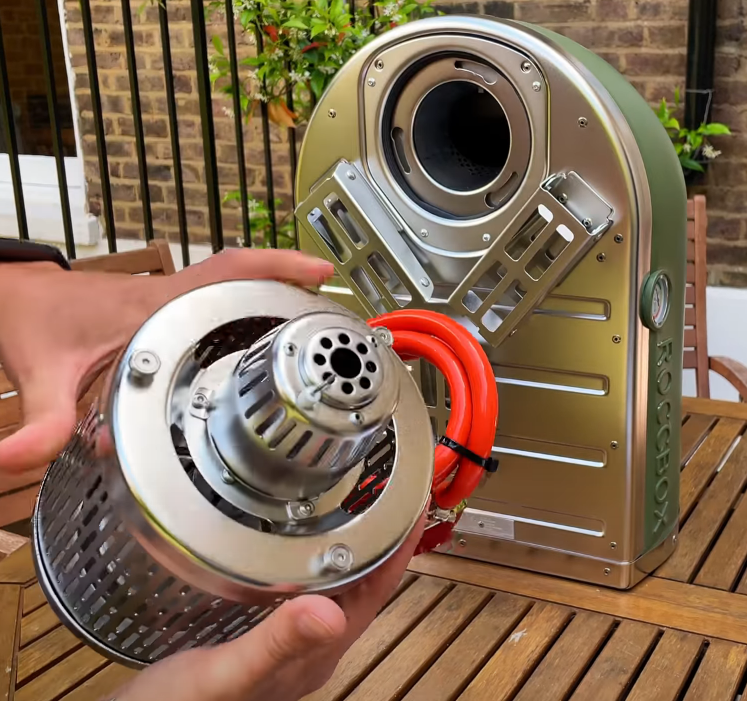
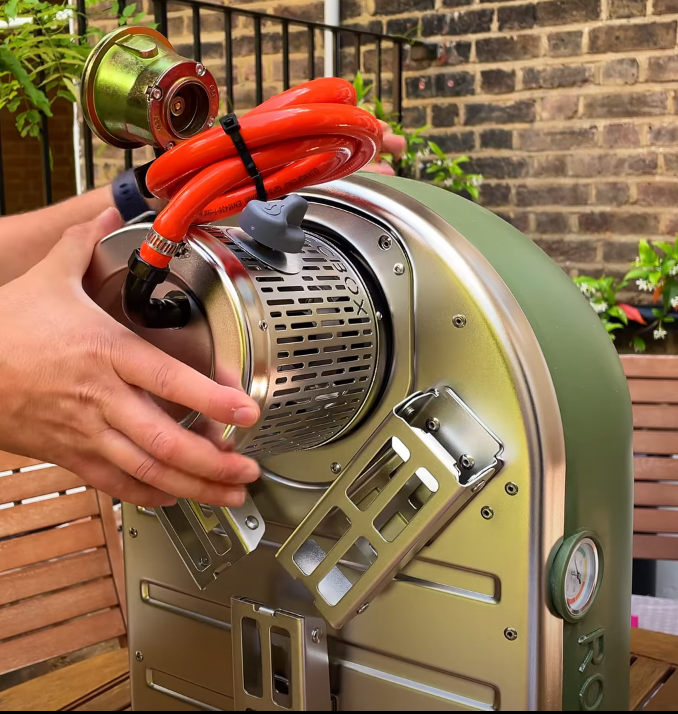
From there, you just unfold its three retractable legs and turn it over on a flat table.
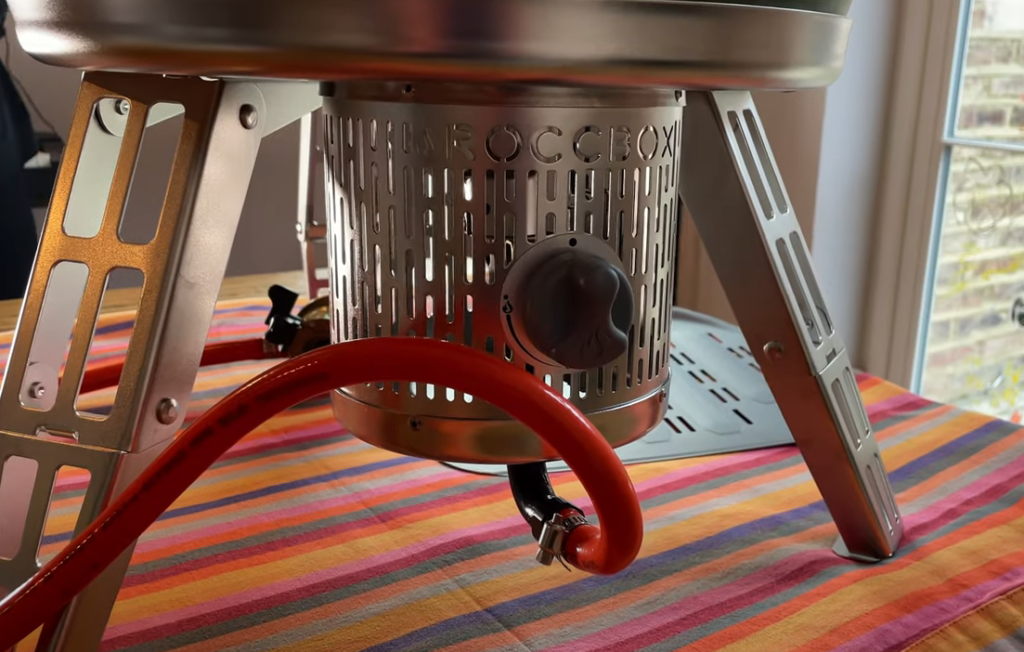
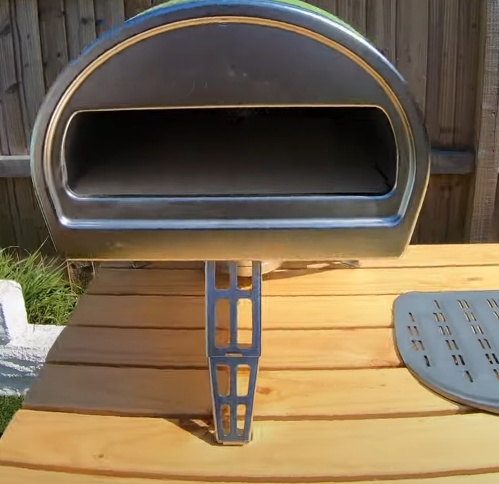
That’s how simple the setup is – no tools are necessary, plus the pizza stone comes fixed into the oven floor. From unboxing to set up it takes about 5 minutes.
The gas and wood burners use a simple yet secure bayonet-style fitting to lock onto the slot (no screws required). This ingenious design makes swapping between the two burners extremely easy.
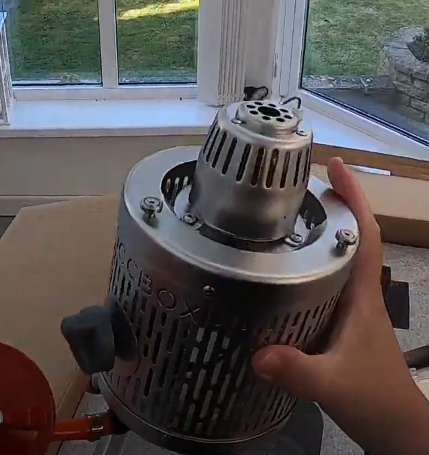
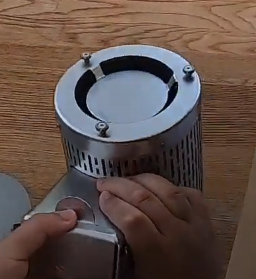
After attaching the burner and standing up the oven, you only need to connect the gas regulator to your propane tank if you’re using the gas burner. The gas regulator comes already hooked to the burner by a hose – it hooks up to a regular 20lb propane tank, like the one typically used for a grill. But, any standard propane tank with a capacity ranging from 9 lbs to 20 lbs will work.
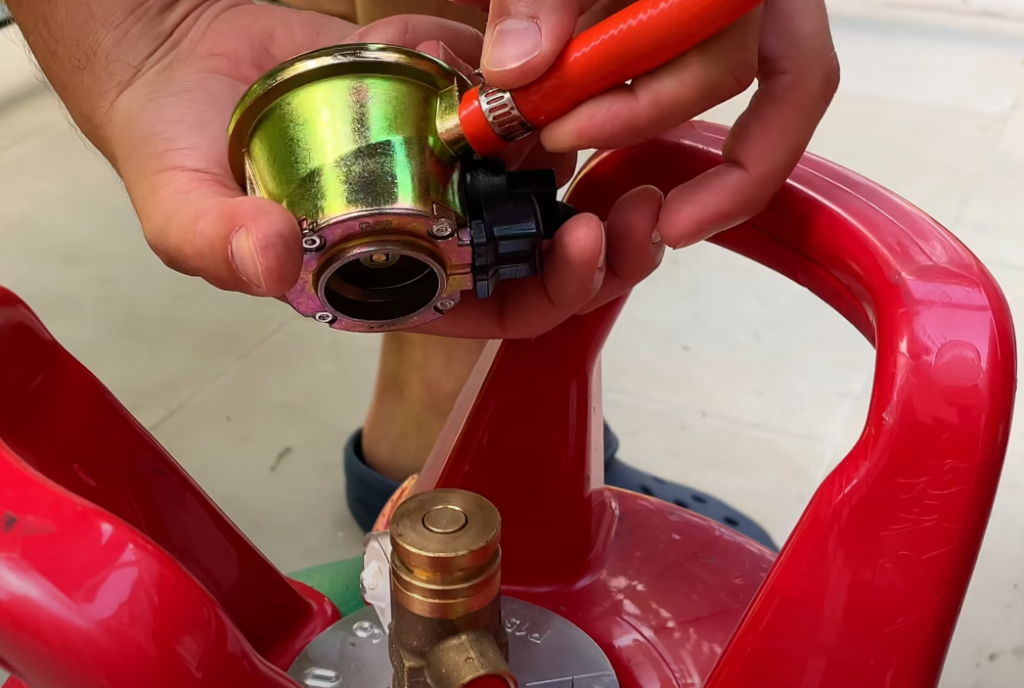
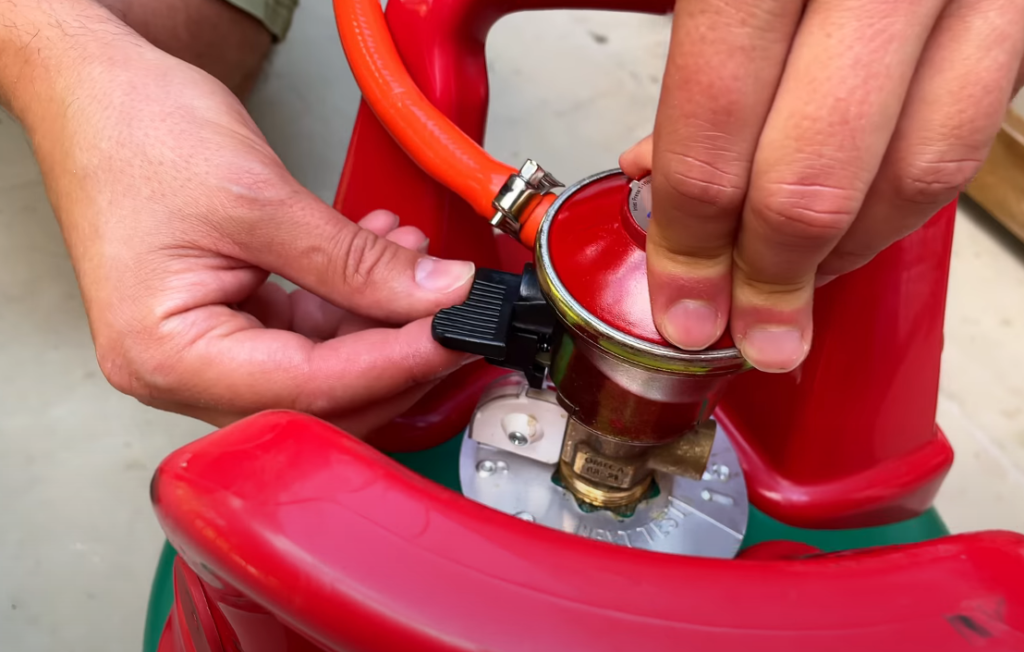
Once we got the regulator secured and tightened to our gas tank, we tested all the connections for leaks with soapy water as recommended in the manual – we found no leaks at all. The wood burner doesn’t need any inspection. Once attached, you just open the hopper, feed in pieces of kiln-dried wood, and start the fire. That’s it!
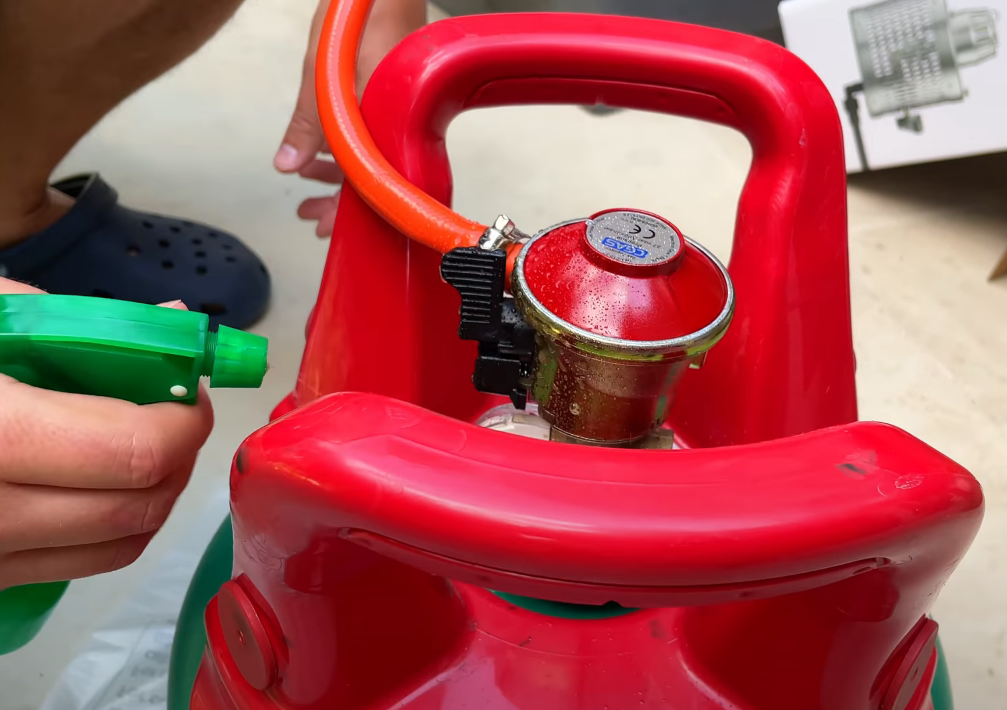
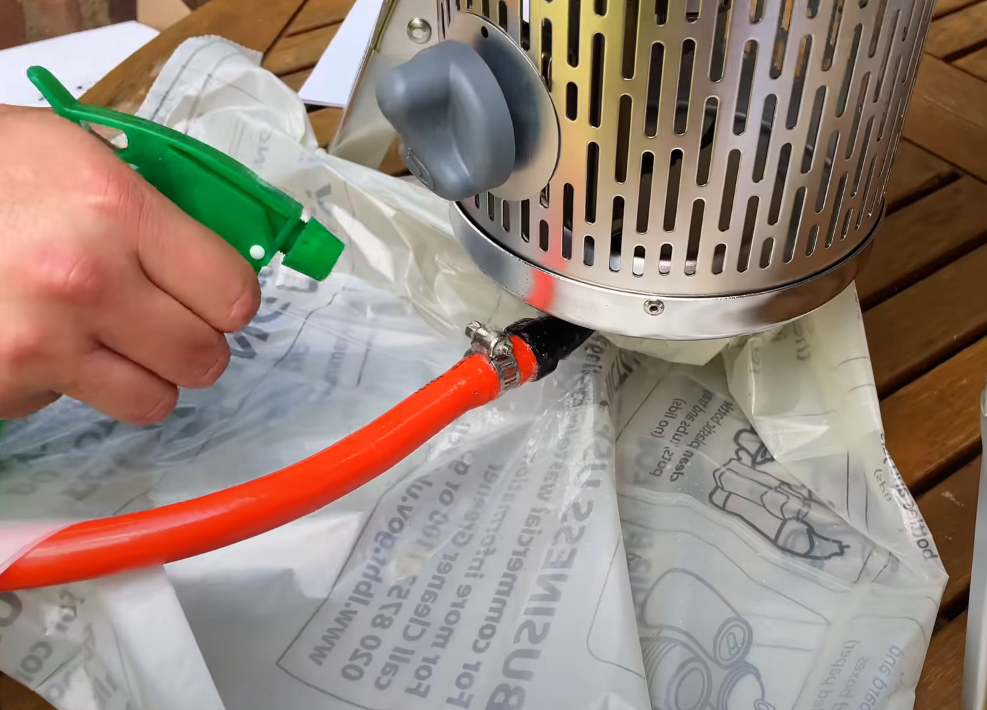
You can set the oven on any flat even surface. Size is not really an issue as its footprint is fairly small, so it will fit on any small table. Moreover, the wide-spaced legs plus the heft of the oven keep it stable and in place, provided you place it on a sturdy, leveled table. At no time during our testing did the oven ever wiggle or wobbled even a bit.
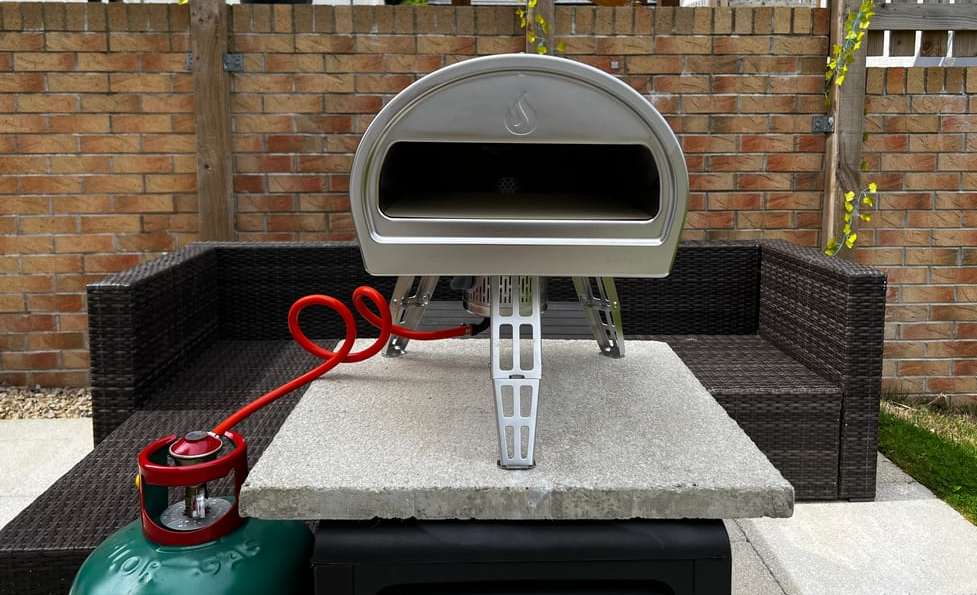
Besides that, the legs are tall, so they place the oven high enough that the surface below it isn’t blistered by the heat despite the burners getting very hot and having a narrow clearance beneath them. Still, it’s good to place it on a surface that’s non-combustible. Metal or stone would be ideal – the gas hose is about 1m long, so you can even set it on a tall table.
The integrated thermometer on the side was a really welcomed addition given that not most pizza ovens come with one. It’s an analog thermometer but it does work. The other accessory that not many pizza ovens offer is the pizza peel. We were glad it was included in the package. It fits the oven fine but it’s quite large.
Our Score: 9 out of 10

Gozney Roccbox
Performance
The performance of the Roccbox was pretty good. It does get screaming hot with temperatures sometimes even hitting over 930°F when using the gas burner. The pre-heat time was decent too and the overall heat retention was excellent as you’ll see. With the wood burner though, the performance wasn’t quite good. We had problems reaching the advertised maximum temperature – the highest we could get to most of the time was around 700 to 800°F. Keeping the heat at that range was equally a challenge.
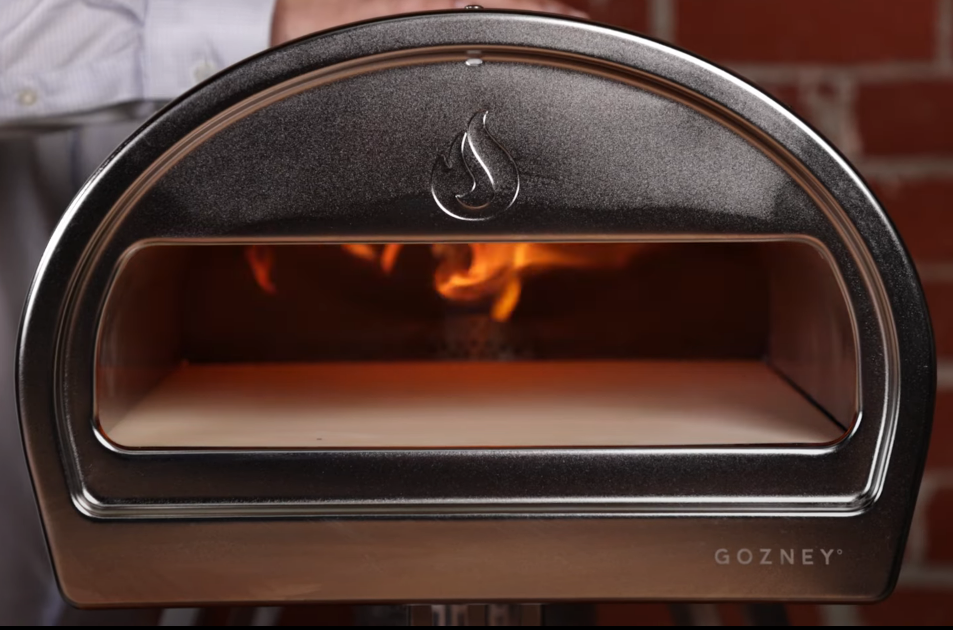
Pre-heating Time
As per Gozney’s manual, you have to first cure the oven for 30 minutes (whether using gas or wood) at a medium temperature and then run it at high temperatures (when using gas) to get it to maximum temperature.
Using Gas Burner
The company states that it takes around 15 to 20 minutes to get the oven to temp after curing when using gas. Well, we followed the instructions and did exactly that. After 30 minutes of curing, we cranked up the heat.
In about 15 minutes of heating, the temperature inside the oven according to our infrared thermometer gun was around 820°F – the temperature on the mounted thermometer was reading 430°F (806°F), which was the temperature of the pizza stone. After another 10 minutes of heating, the temperature inside the oven had reached an impressive 924°F while that of the stone from the readings of the built-in thermometer was about 490°C (914°F).
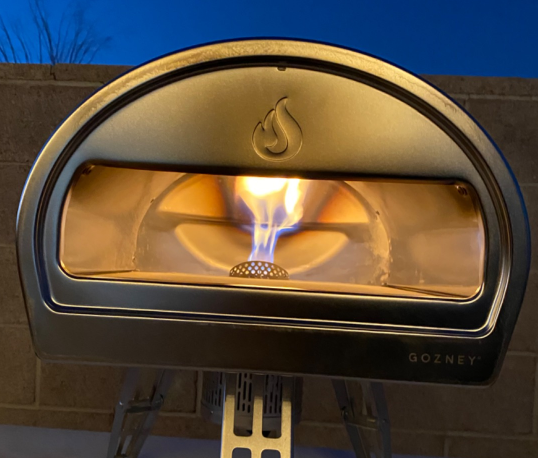
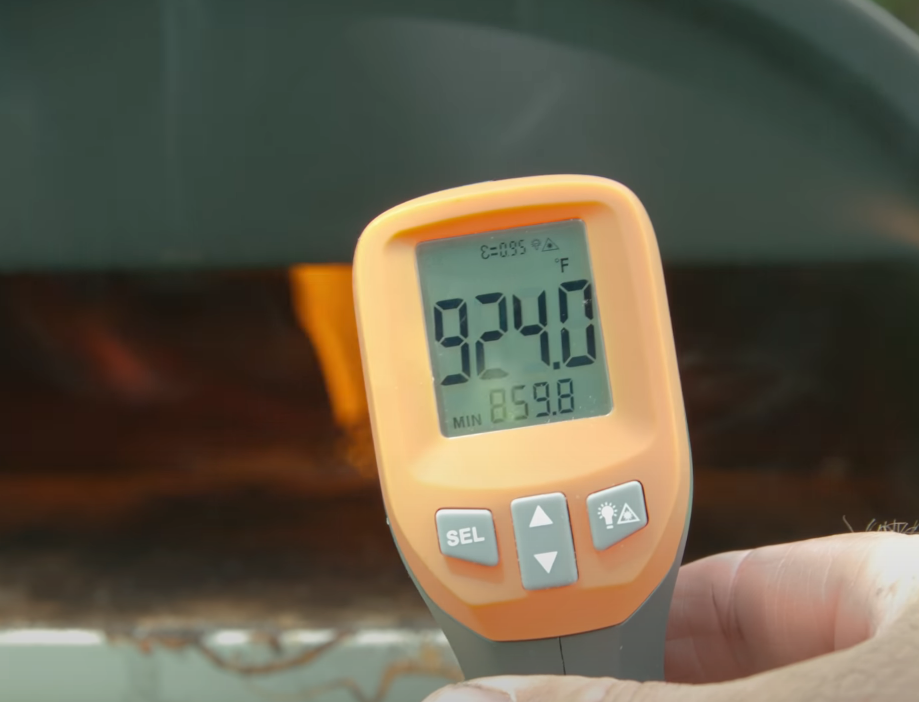
So, you’re looking at around 45 to 60 minutes to get the oven ready for cooking when using gas. It’s a decent preheat time but certainly not the fastest compared to other ovens given that we did the test on a mild 68°F day with little wind – it could take slightly longer on a cold, windy day.
Using Wood Burner
While the Roccbox was able to exceed 900°F in less than an hour during our first trial with the gas burner, it wasn’t the same case when we used wood. Even after leaving it to cure for 30 minutes, we could not get it in the 900°F range. After 30 minutes, the temp was around 415°F.
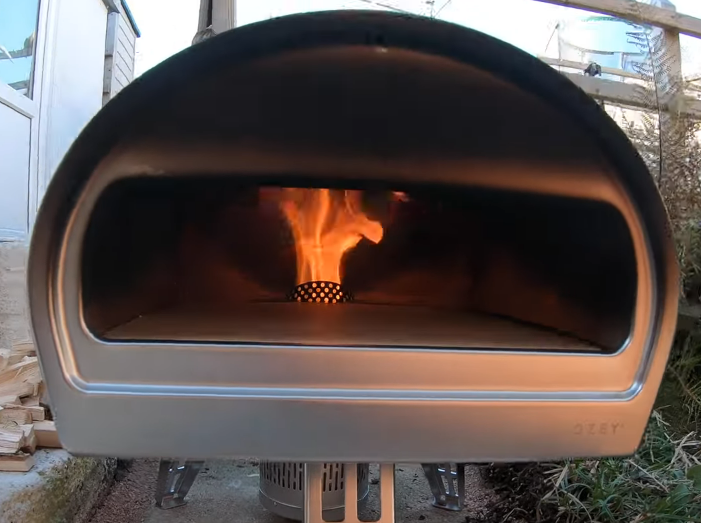
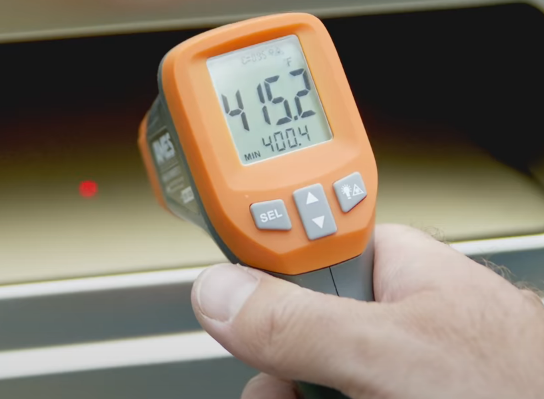
We gave it another 30 minutes of preheating and when we checked the temperature, it had only reached 750°F. It never got to rise past 800°F and this was on a mild day too – around 54°F outside, with not much wind.
We thought the result would be better on a hotter, calm day, but it wasn’t so. The oven still couldn’t heat to over 900°F as advertised. The best it could do was 800°F, which required more than an hour of work to get to – it may certainly take far longer than that on a cold, windy day.
Airflow System
The Roccbox features Gozney’s patented baffle plate technology which creates a unique rolling flame that stretches from the back all the way toward the opening at the front. It has no vents or a chimney for creating the draft that carries the flame all across the oven’s interior. It only relies on this technology and it really works as stated, especially with the gas burner.
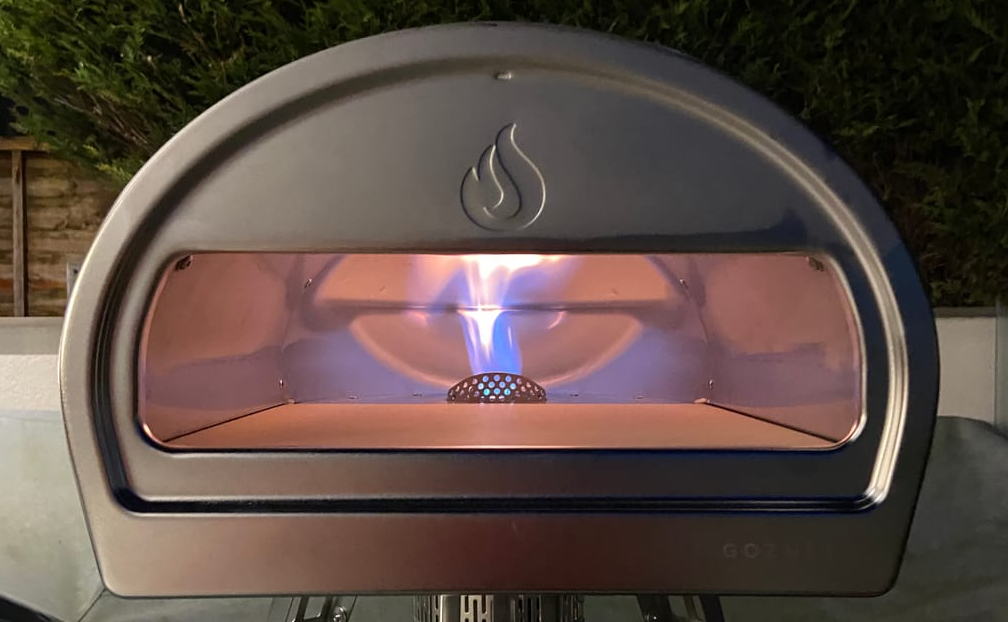
Using Gas Burner
The moment we lit up our Roccbox oven, the flame immediately came up and it was the traditional yellow rolling flame similar to a wood-fire flame.
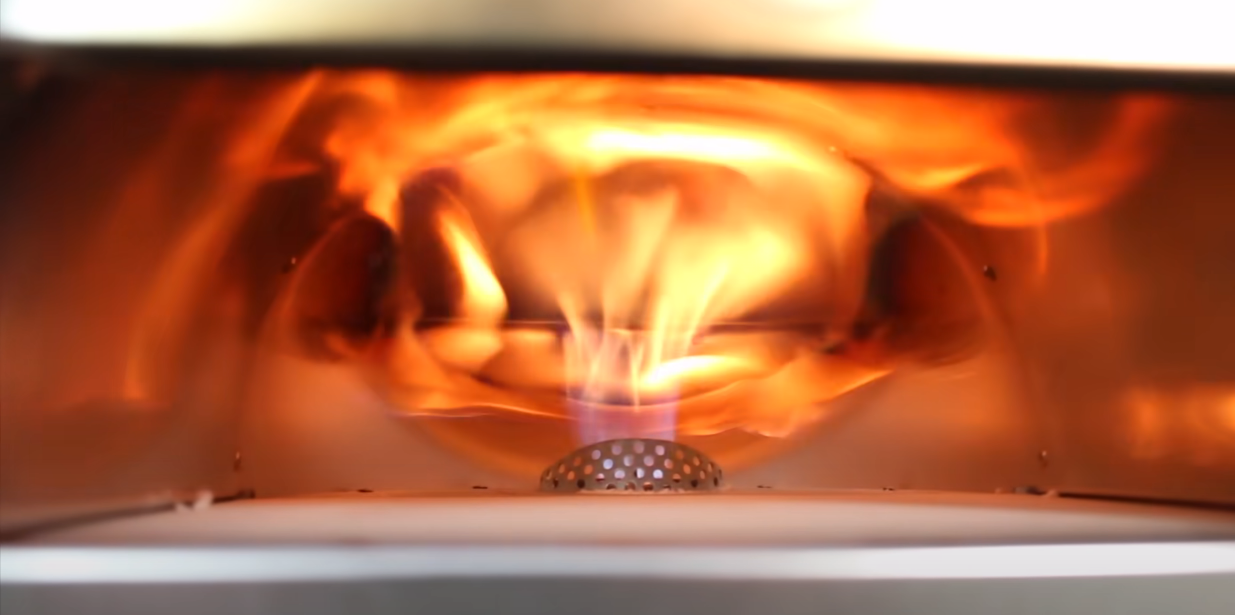
It was intense at first as we had turned it to maximum but we retracted it a bit to cure the oven as the manual instructed. The flame stretched up from the gas burner at the back, then across the roof of the dome-shaped interior, and finally towards the oven’s opening.
The result of this is that the entire interior heats up uniformly. We tested this and found that only the back section, near where the flames come from was hotter than the rest of the cooking surface. Furthermore, we noted only a slight difference – of about 10°F – between the temperature of the pizza stone and the oven’s ambient temperature.
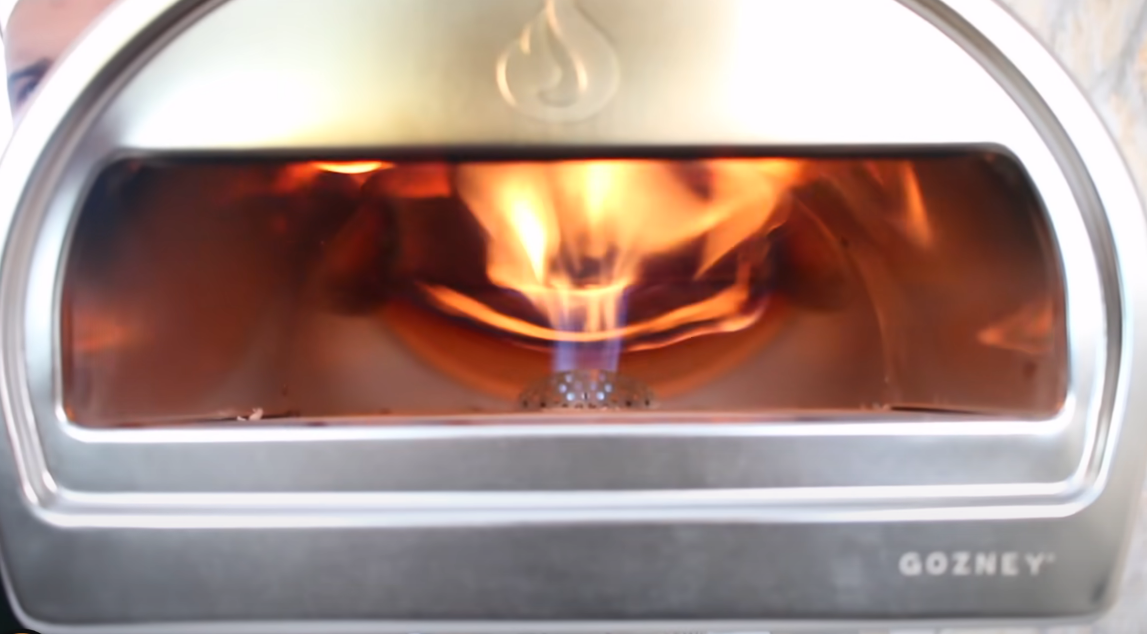
The flame reaches up to the door, so it nicely rolls over the pizza and at just the perfect distance since the domed ceiling is fairly high. Hence as the bottom cooks, the toppings get to cook well too without ending up getting burned. The part that we found chars more quickly is the edge of the pizza closest to the back – it gets the most heat as it’s near where the flame emanates from.
Controlling the flame and the heat is easy too when using gas. The gas burner has a knob that allows you to either raise or lower the heat level and the size of the flame. It’s that simple.
Using Wood Burner
The design of the wood burner was quite clever as well. The burner/fire basket is not solid. It’s well-ventilated with lots of holes in it to allow for a good draft. It’s an ingenious design that helps with airflow just like a chimney.
The holes draw the air in and up the burner which not only jacks up the fire but also makes the flame shoot out of the burner’s top, go up the oven’s roof, and almost as far as to the opening. As such, the oven’s interior gets heated well and the resulting vacuum draws more air back through the holes of the burner to feed the fire again and keep the flame rolling.
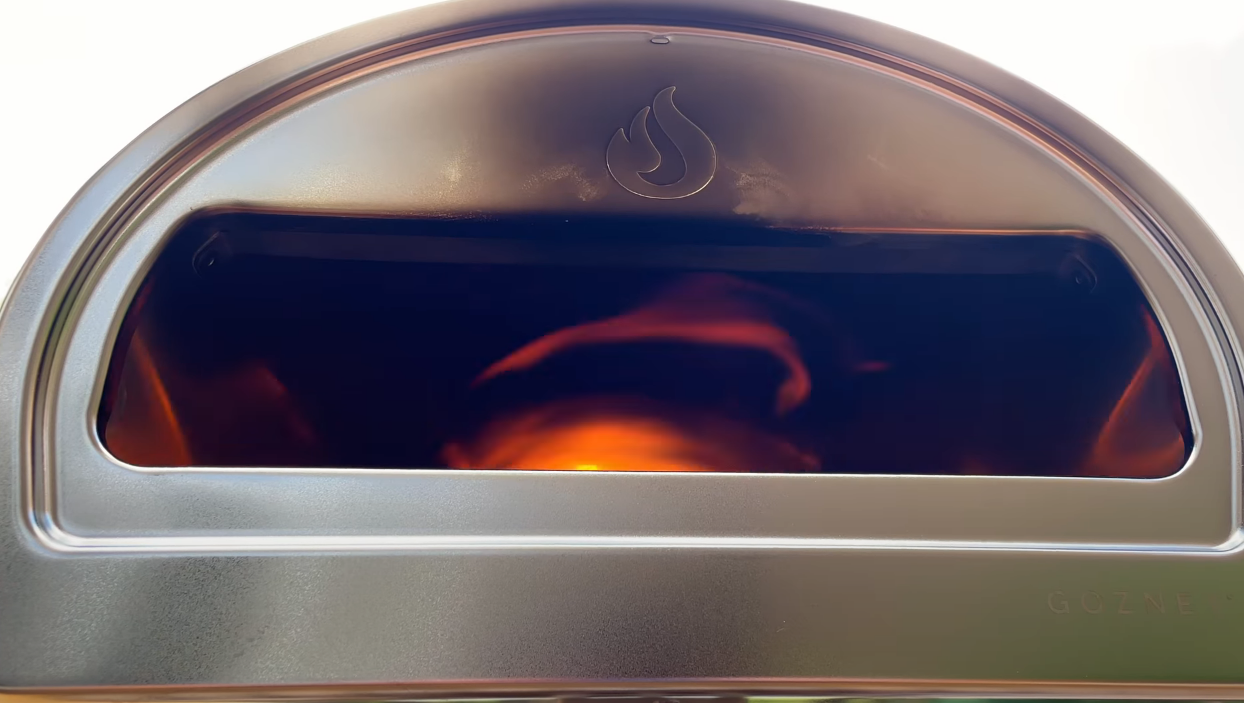
It works superbly. The problem is that you have to constantly feed the burner wood for the fire and flame to keep going. The hopper itself is basically a small cylinder with a narrow chute, therefore, you can only get a handful of wood into the fire chamber at once.
Moreover, every time you top up the wood, the temperature would first drop a bit and then rise when the new wood fires up completely. That’s why it’s hard to get the oven hit the same high temperatures you get with gas. You definitely need some experience maintaining and controlling wood-fire flames to get it hot enough on your first try.
Heat Retention
The Gozney Roccbox retained heat exceptionally well compared to other similar pizza ovens we’ve tested. This is solely attributed to its dense insulation which consists of a thick layer of calcium silicate that runs from the top to the back and the sides too – it’s even much thicker in the back area where the flame comes out from.
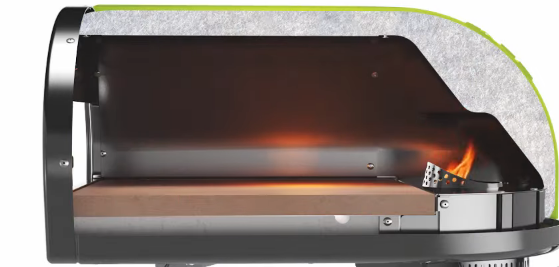
The thick silicone outer casing, covering the whole exterior (except the bottom and the front), also helps keep the heat in. It’s certainly very robust insulation, probably denser than any other portable pizza oven on the market.
Using Gas Burner
Whenever we hit the target temperature (around 930°F) when using gas, the oven stayed hot at that same temperature throughout our cooking session until we either lowered the flame or turned it off. It also held the stone temp certainly better than the Ooni ovens. The 19mm-thick cordierite stone absorbs heat very well and then retains it for a long time.
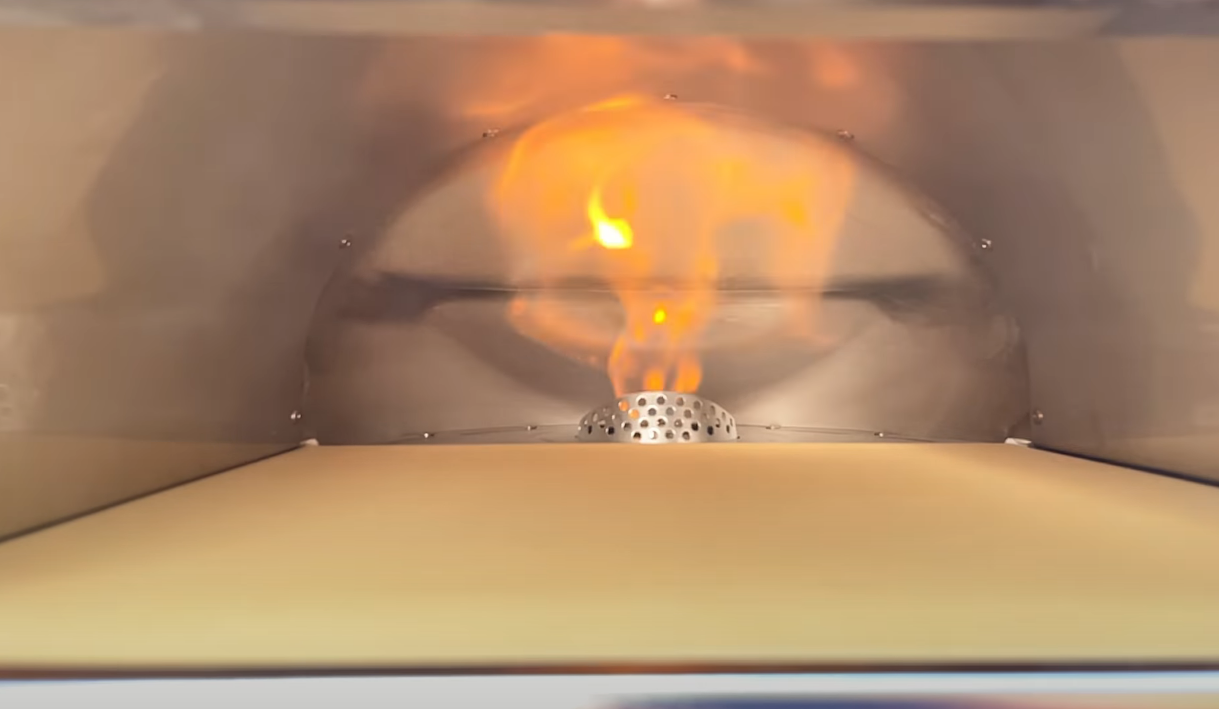
Before placing our first pizza, the reading on the built-in thermometer which measures the stone temperature was 924°F. It remained that way even after the second and third pizzas. We confirmed that the built-in thermometer was indeed showing the correct stone temp and for sure the reading was pretty consistent with what we got from our infrared thermometer.
In short, both the oven and the stone stay hot when using the gas burner. There’s no warmup time needed between pizzas. We were able to cook pizzas back-to-back, no waiting up to 10 minutes for the stone to heat up again after a pizza like in other ovens. Furthermore, the microporous composition of the Roccbox’s stone helps draw moisture from the pizza dough as it bakes, hence the bottom gets char properly. All the pizzas we cooked using the gas burner had crispy bases – the bases were never soggy like it’s common in ovens using thinner stones.
Using Wood Burner
As mentioned earlier, keeping the fire going when fueling with wood was a big challenge. Even with the great heat retention of the Gozney Roccbox, it wasn’t easy to maintain the same level of heat with the wood burner. We had to consistently feed wood to the hopper to rekindle the fire, otherwise, the temperature would drop as we continued using the oven.
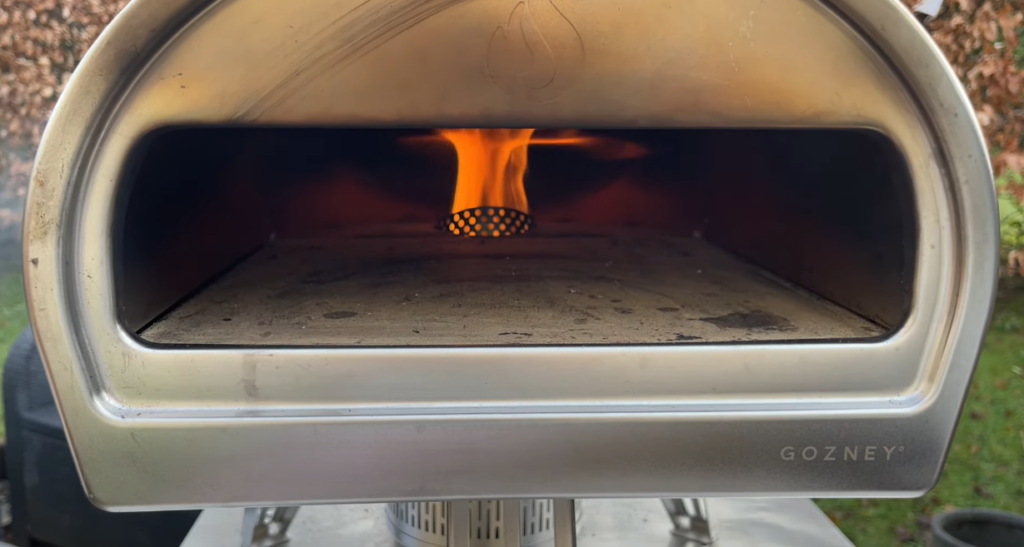
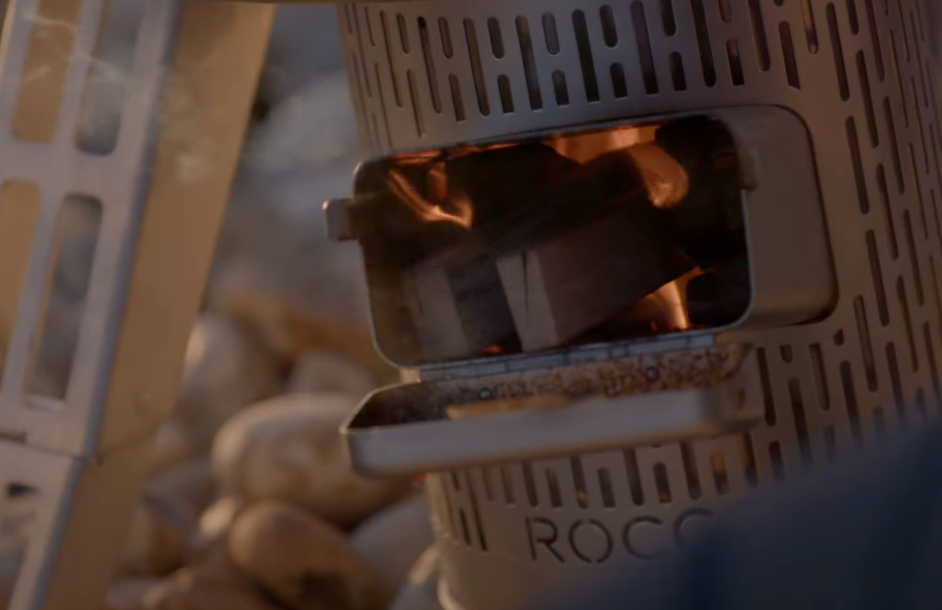
It definitely takes more work compared to gas and the positioning of the burner outside the oven doesn’t help much either as some of the heat gets lost through the back. So, in general, using the wood burner requires constant babysitting to ensure the heat remains consistent. We found it hard to make pizzas back to back as the temperature tends to drop a bit after adding wood, requiring some warmup time to get the stone and oven hot again for the next pizza.
Overall, we found the performance of the Roccbox to be far superior when using gas than wood. The lack of a door wasn’t really an issue for us since most of the days we were testing the oven, the ambient temperature outside was mild (50°F to 70°F) and it was less windy.
However, the flame can get blown out easily if it’s breezy – far beyond the opening which can be unsafe. We didn’t have such an experience but one thing we noted was that although most of the oven heats up uniformly, the back was always hotter than the front, which is not unusual at all. The only way to combat this is to keep rotating the pizza until it’s cooked all through.
Our Score: 8 out of 10

Gozney Roccbox
The Results
We truly enjoyed cooking with the Roccbox, particularly with gas. The results were impressive and consistent – almost all our pizzas came out cooked perfectly on the bottom and the top.
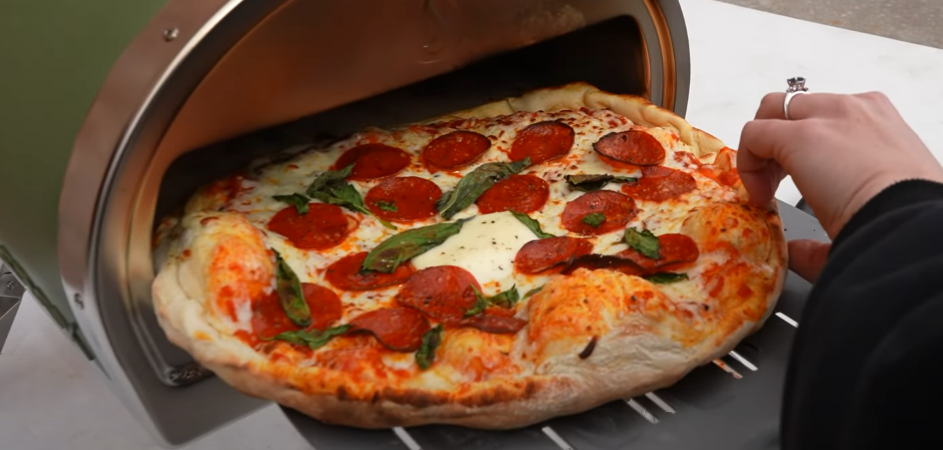
Cooking with Gas
We got great results right from the start when we used gas. Every pizza we tried was perfectly done – crispy bottom, cooked all through, and just the right char on the toppings.
First Pizza
We started with the signature Neapolitan-style pizza with the usual toppings of tomato sauce, fresh mozzarella cheese, and some basil leaves. We used just standard fluffy pizza dough.
After about 90 seconds of cooking, we removed the pizza and the end result was a roaring success. The dough was puffed up very nicely with the crust having that distinct Neopolitan bubbly char. Even the toppings got a nice char with a little browning on the mozzarella cheese which was perfectly melted
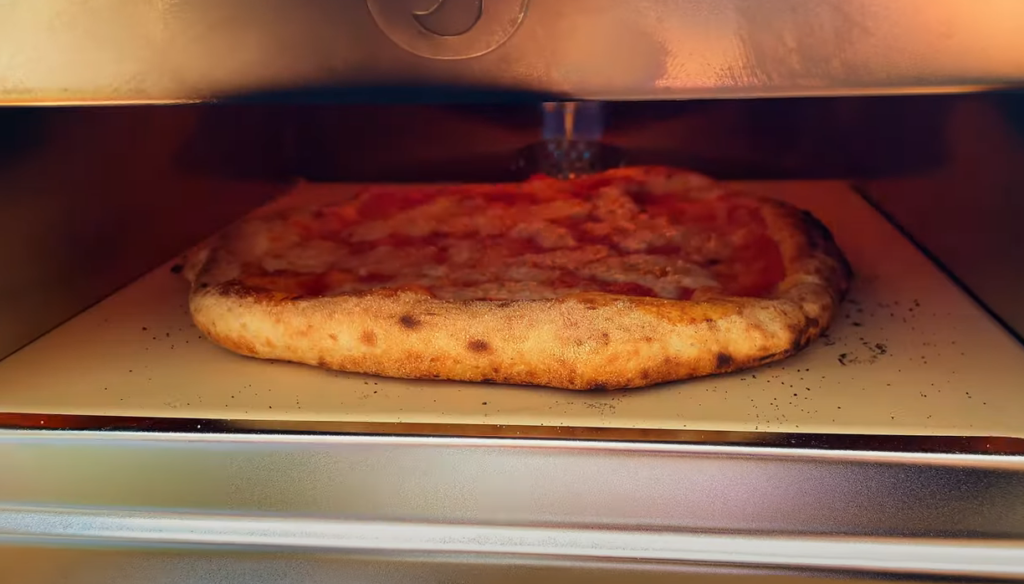
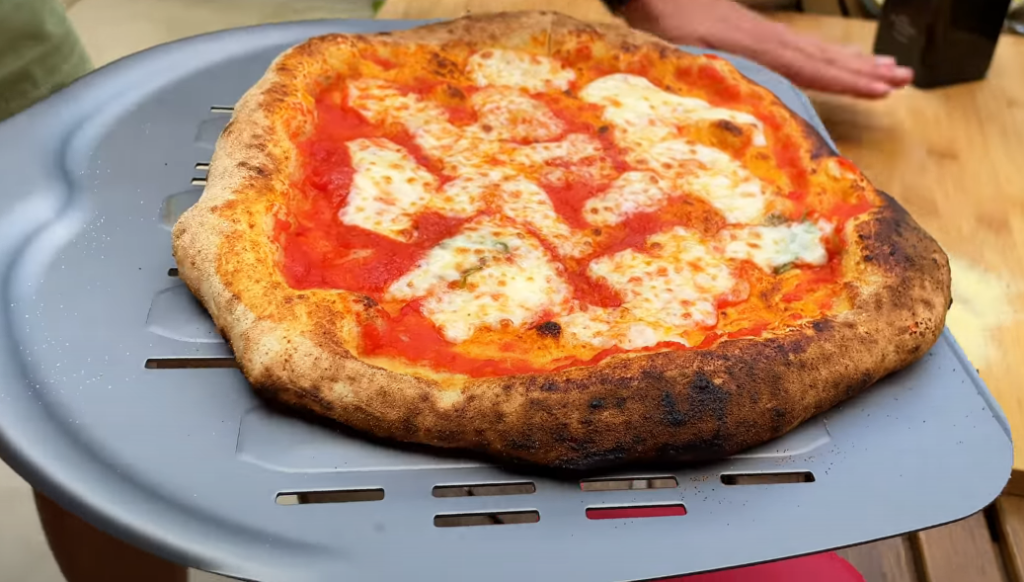
The bottom came out with almost uniform leoparding (speckled charring). It truly had an authentic Neopolitan look and also tasted like one.
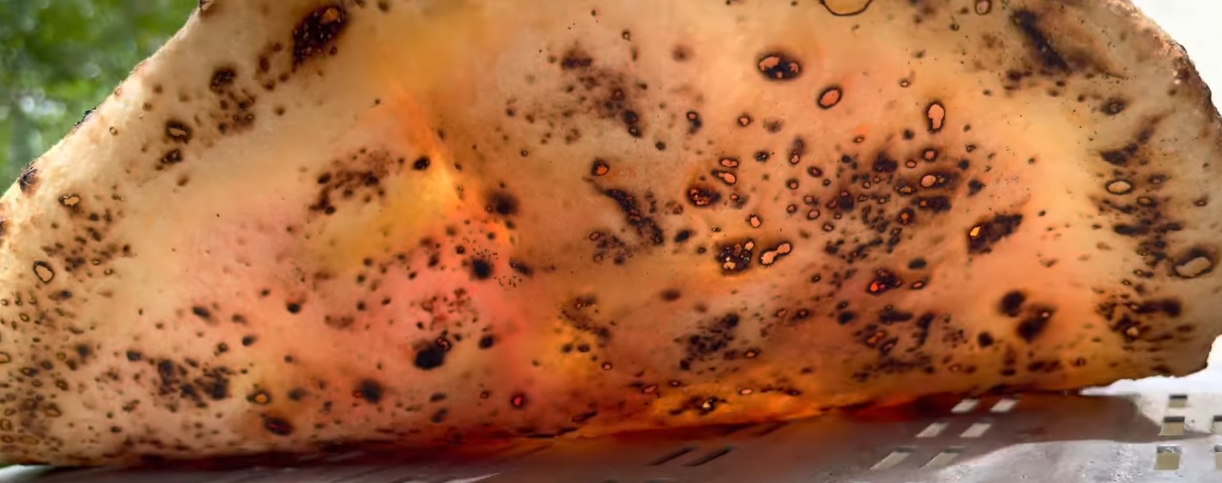
The crust was crispy while its interior was chewy and soft, exactly like we expected. The hot stone had drawn nearly all moisture from the dough, hence making the base deliciously crisp too. The melty toppings also tasted great – the cheese was stretchy just how we like it.
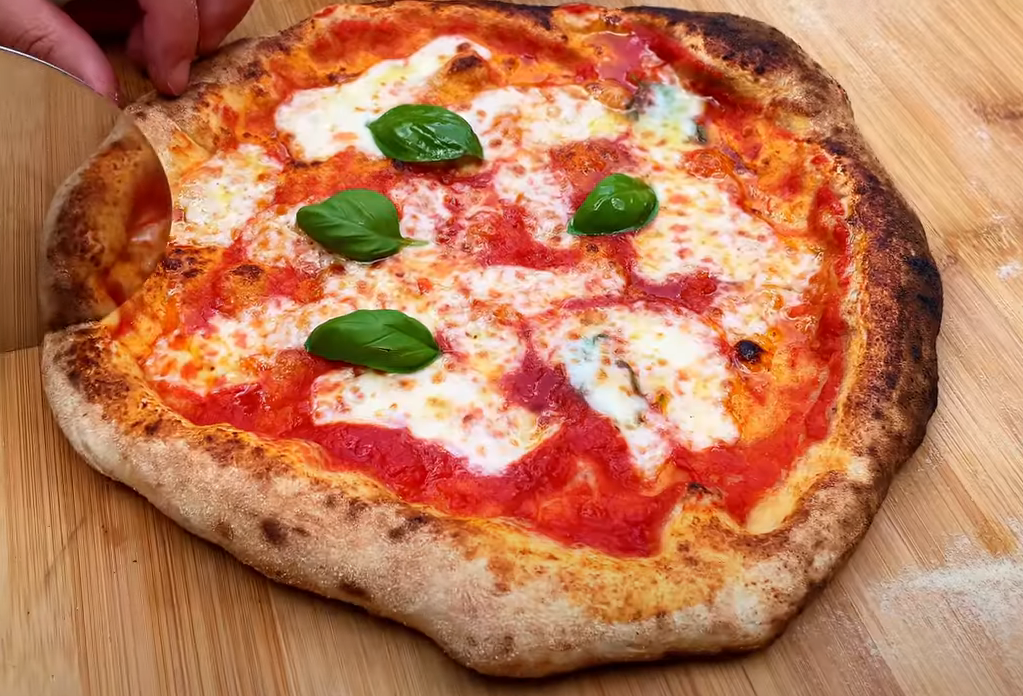
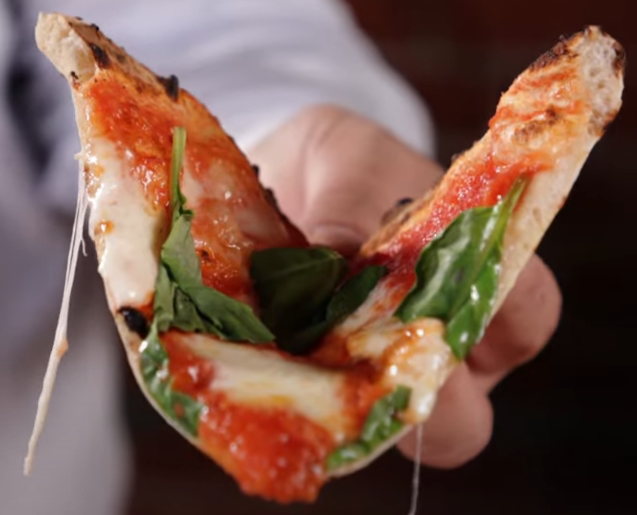
Second Pizza
Our second pizza was pepperoni and jalapeño pizza. Once we got our dough ready, we sauced it and topped it with a generous amount of mozzarella cheese. We then added the pepperoni and finally the jalapeño – with about half an inch around the edge of the dough uncovered.
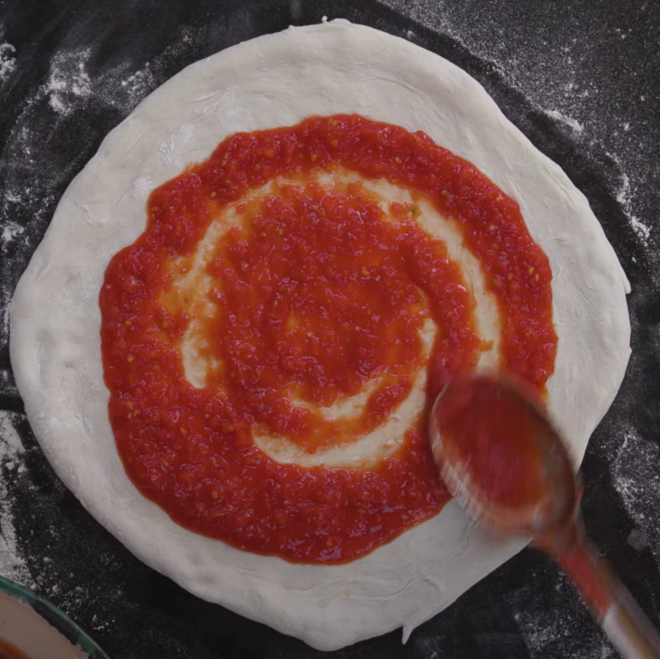
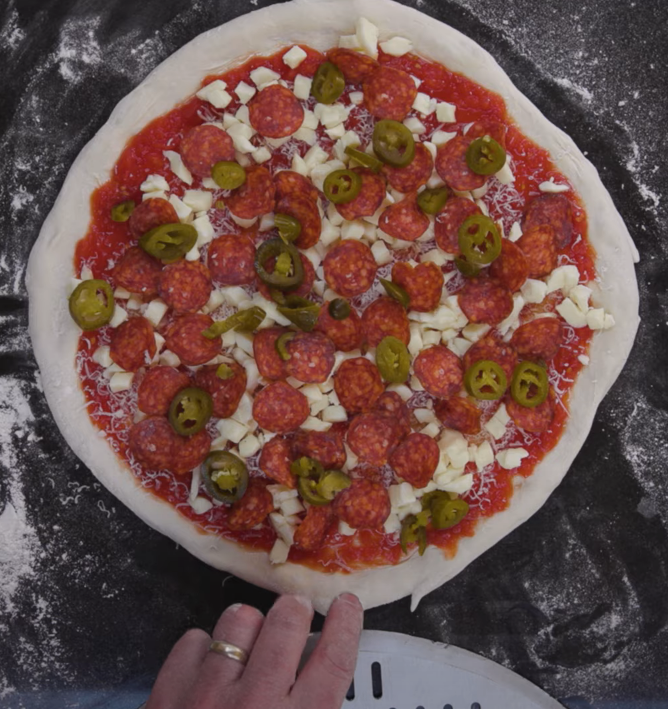
We placed the pizza into the Roccbox and let it cook as we turned it several times.
We placed the pizza into the Roccbox and let it cook as we turned it several times. What we got at the end was a beautifully cooked pizza. It was perfectly done all through. The crust wasn’t fluffy like our Neapolitan-style pizza but it was fully baked – it was golden brown with a decent amount of leoparding on the bottom. The mozzarella cheese had nicely caramelized on the dough and the toppings got cooked well too. The jalapeños mellowed out a little but had a nice char while the pepperoni had cupped up and was also slightly charred.
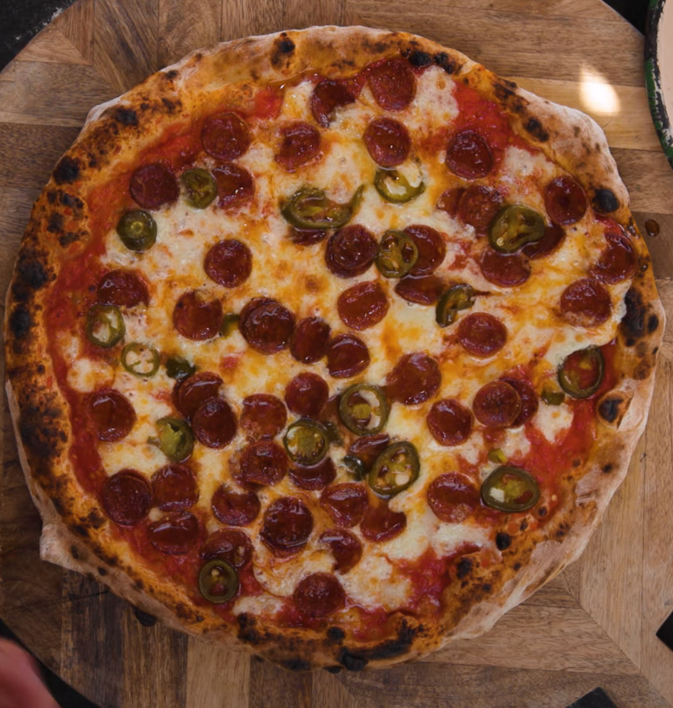
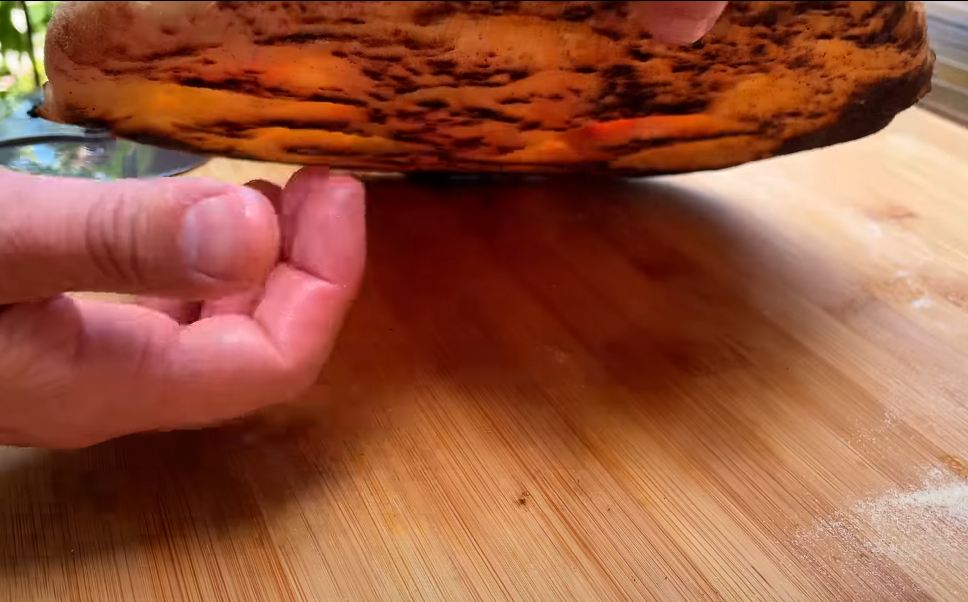
The whole pizza looked amazing and it was pretty tasty as well. The crust was crispy, even on the bottom while the inside was soft. The caramelized mozzarella cheese was gooey and stretchy – it tasted delicious with the source and the crispy pepperoni and spicy jalapeños. The jalapeño sort of infused the oils into the pepperoni as they baked on top of them. It was so good – the slight kick of the jalapeños paired nicely with the heat in the pepperoni. We loved it.
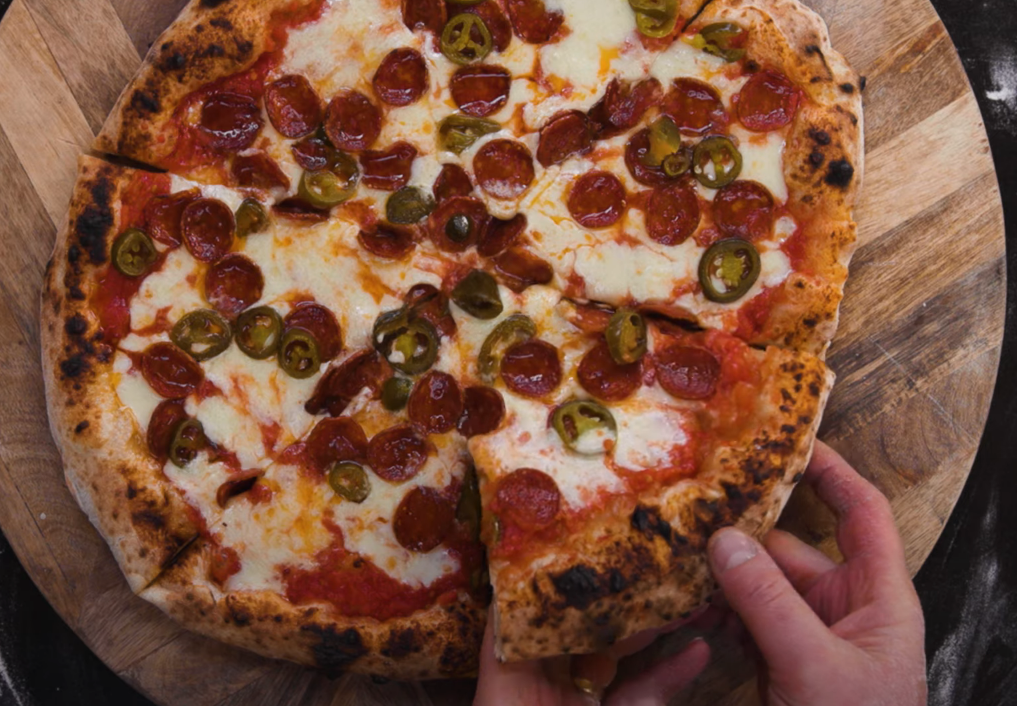
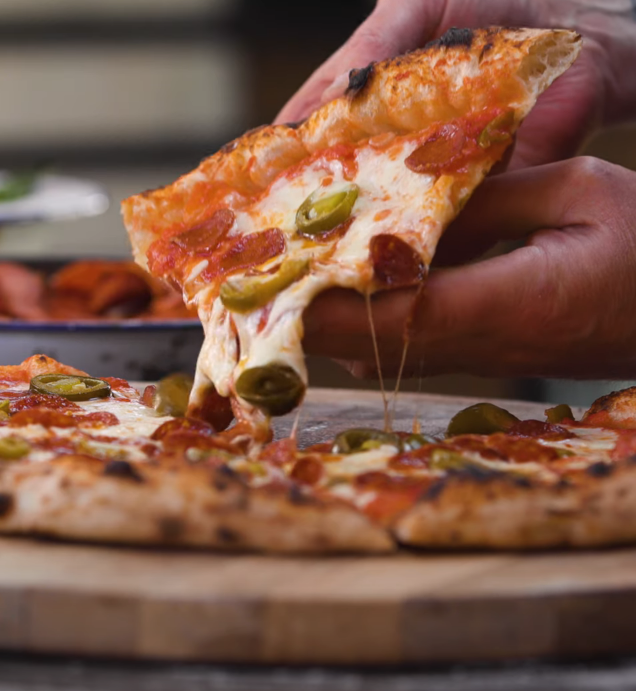
Third Pizza
With the first two pizzas turning out great, we decided our third try would be a thicker-crust pizza with fairly loaded toppings. We went for our favorite, the BBQ chicken pizza. With our dour set, we evenly spread the BBQ sauce on it and added the toppings which included slices of mozzarella cheese followed by chopped grilled chicken, fried sliced mushrooms, fried sliced red onions, and then finally crushed rocket leaf (Aragula).
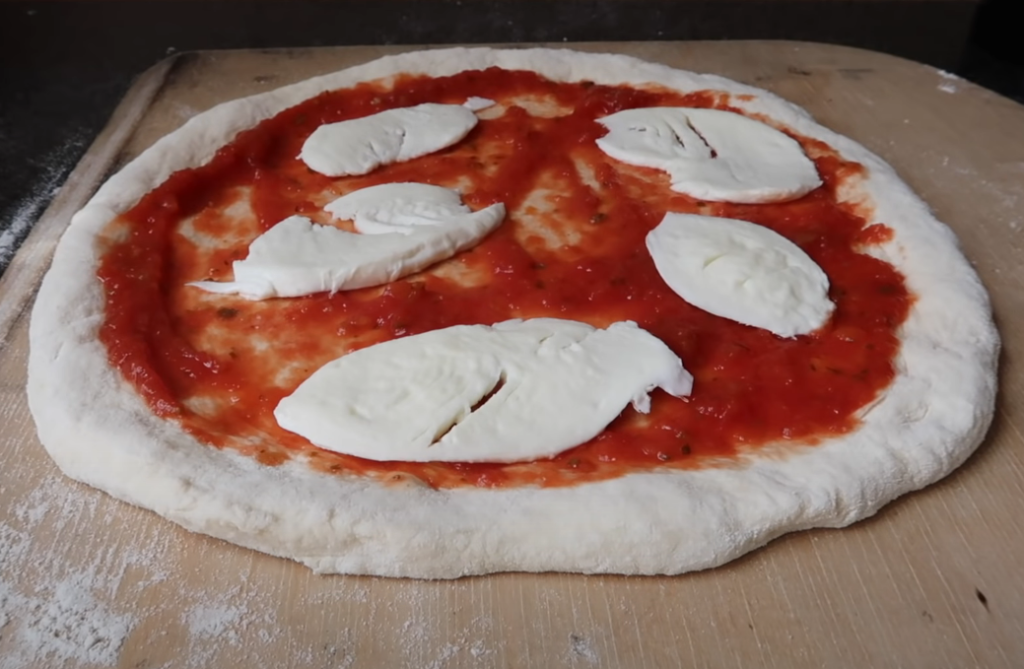
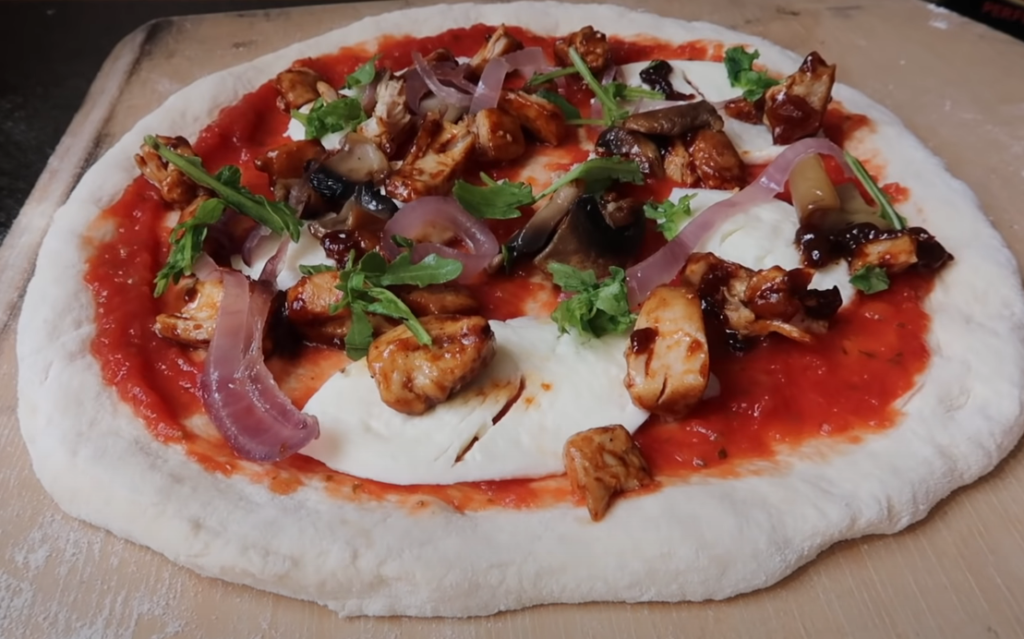
It was a little more toppings than the other pizzas and along with the thick dough, we were concerned that we may end up with an undercooked crust. That wasn’t the case. The thick crust was cooked thoroughly all through. It had puffed up nicely. The half-inch outside edge with no sauce got neatly ordered bumps that had just the right char to make the pizza look beautiful.
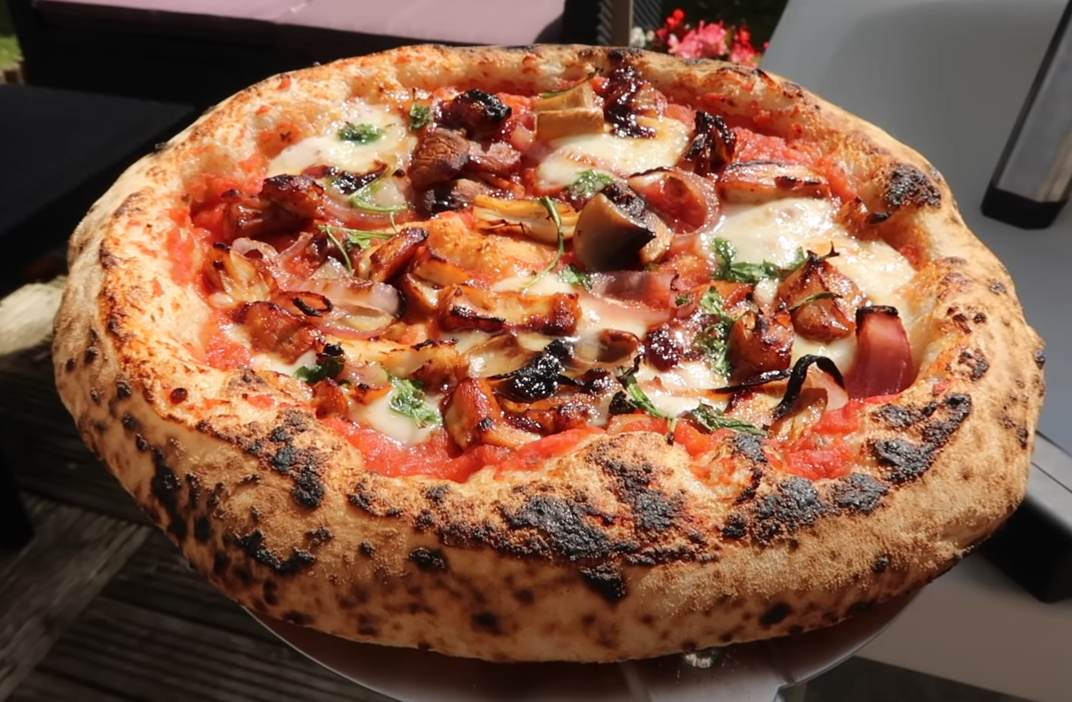
The base of the crust was really crisp with almost even leoparding, a bit more than the other two pizzas. The toppings cooked through perfectly too and they were nicely browned.
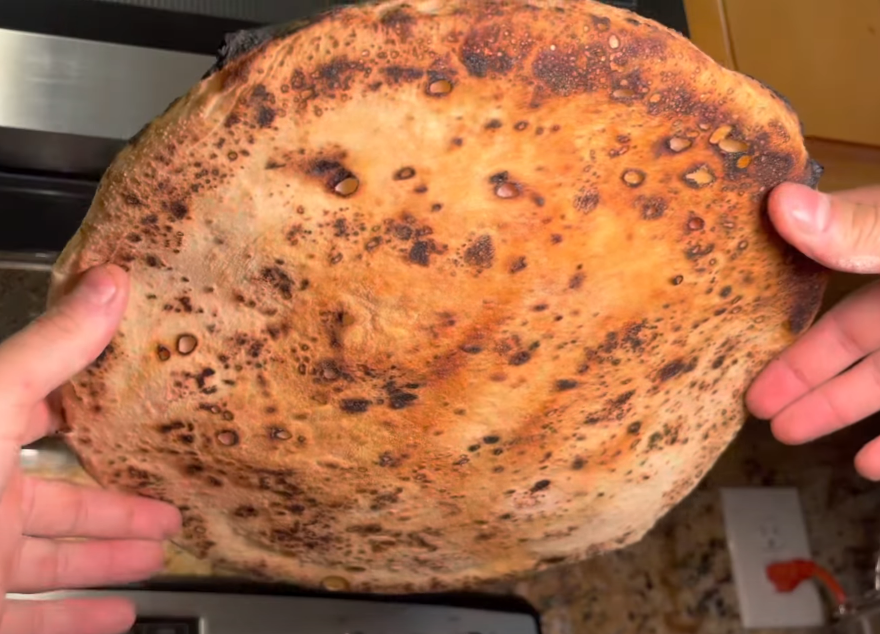
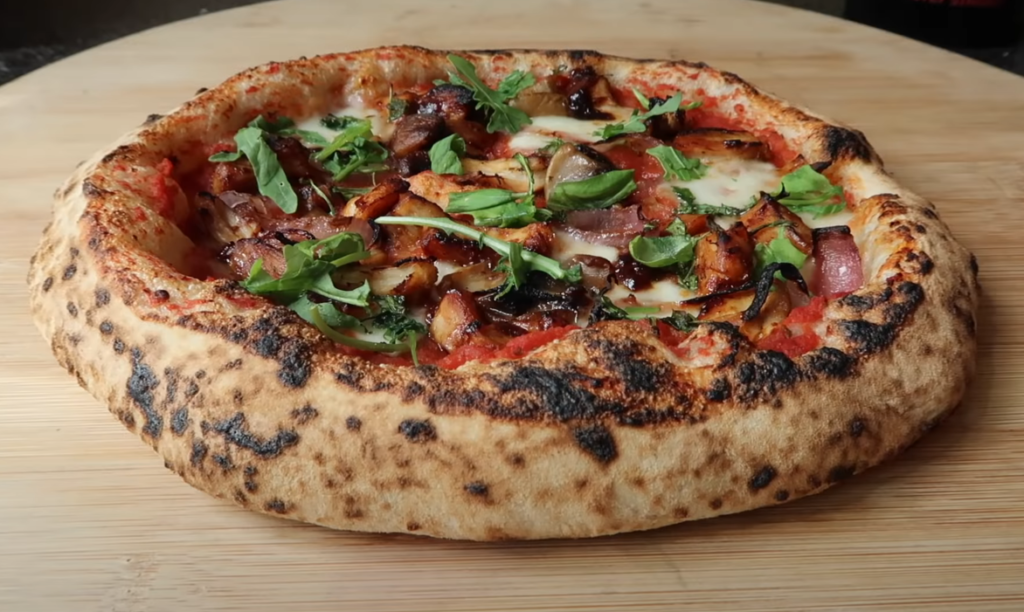
In short, the BBQ chicken pizza turned out to be a nice bubbling cheesy goodness that tasted delicious. The crust was nice and crunchy with a soft center. We did really enjoy it.
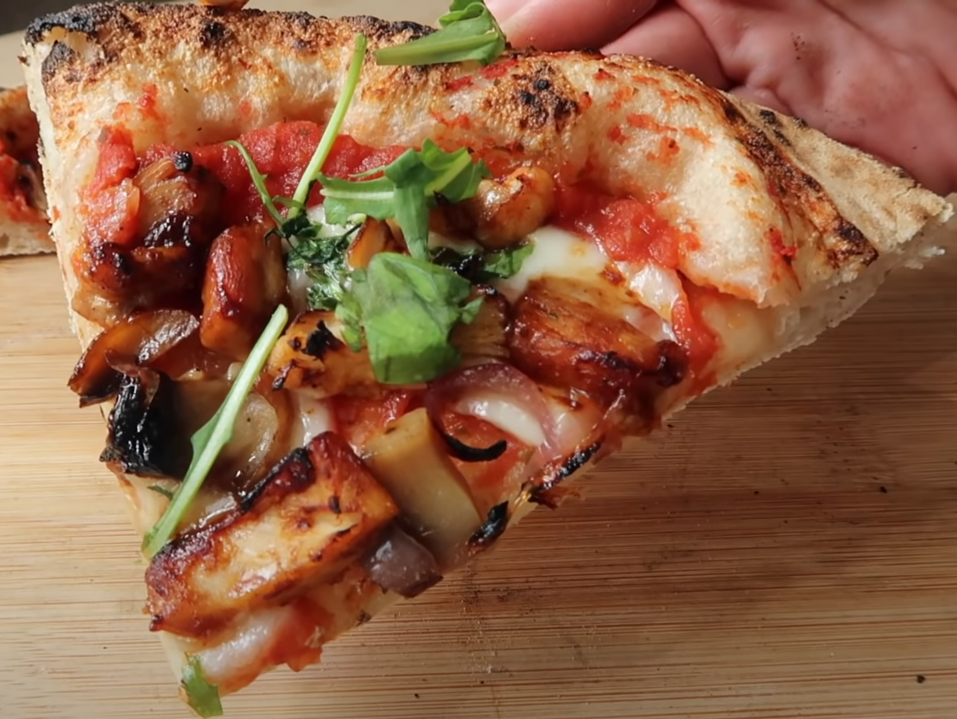
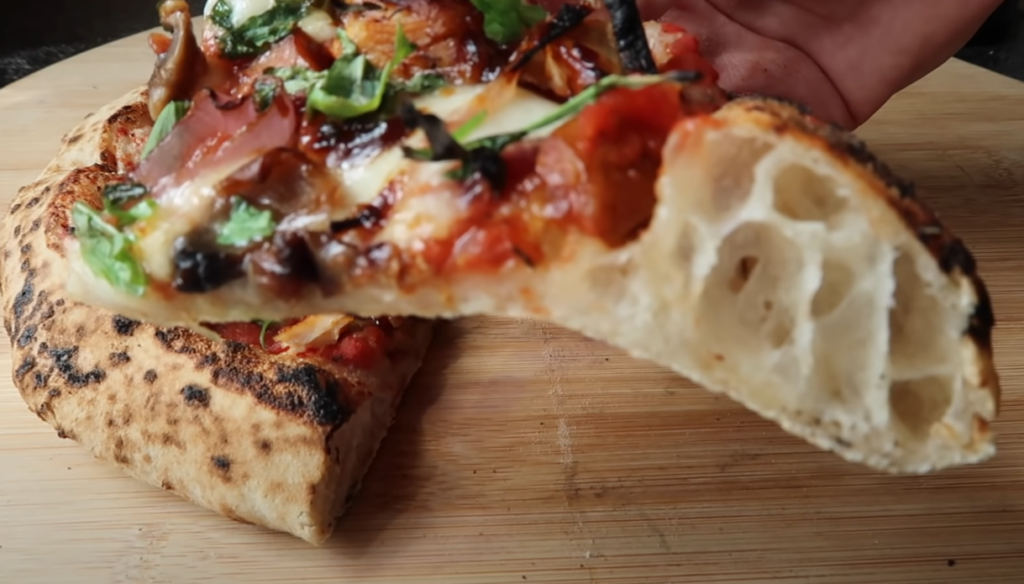
Besides the BBQ chicken pizza, we did a Detroit-style pizza which is another thick-crust pizza and it was cooked well too without issues. We made a couple of other pizzas as well, including Margherita and New York-style pizzas and they turned out great.
Overall, with the gas burner, you get impressive results right from the start – provided you don’t overload the dough with a lot of wet toppings. The balance between the top heat and the bottom heat is excellent such that all the pizzas come out well done, especially when you use Gozney’s pizza dough recipe – we always got the best base whenever we used it.
Cooking with Wood
Unfortunately, our experience cooking with wood wasn’t quite pleasant as almost all the pizzas we made came out bad. The first pizza, which was a Neapolitan-style pizza did turn out okay – not perfect, but okay. The edges of the dough had bubbled and were charred nicely while the toppings were cooked well. The crust was fairly crispy on the bottom and soft inside.
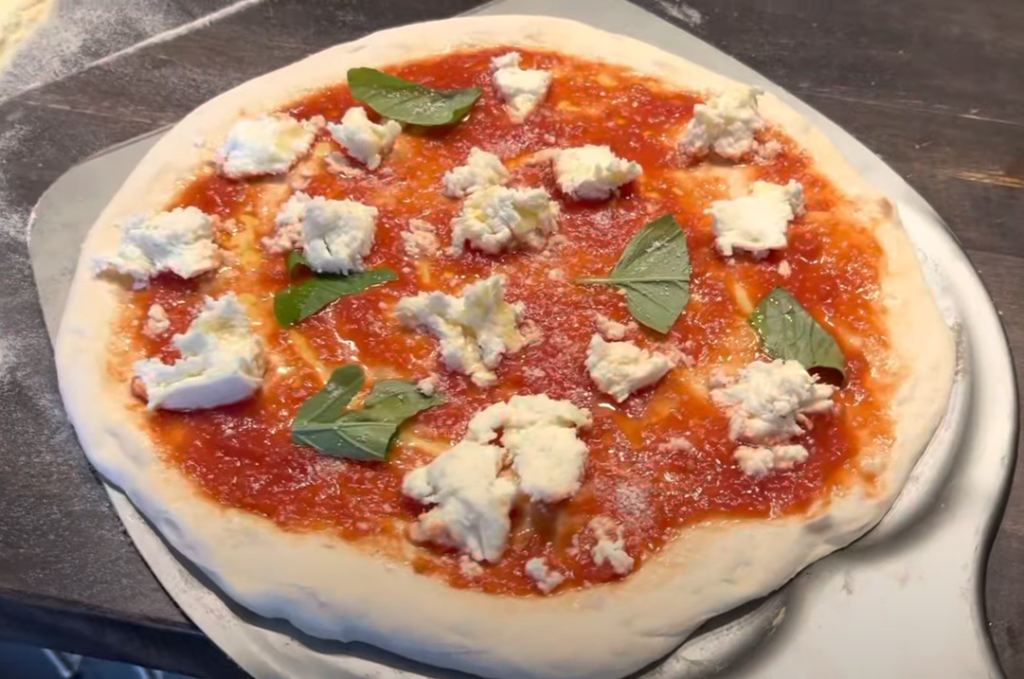
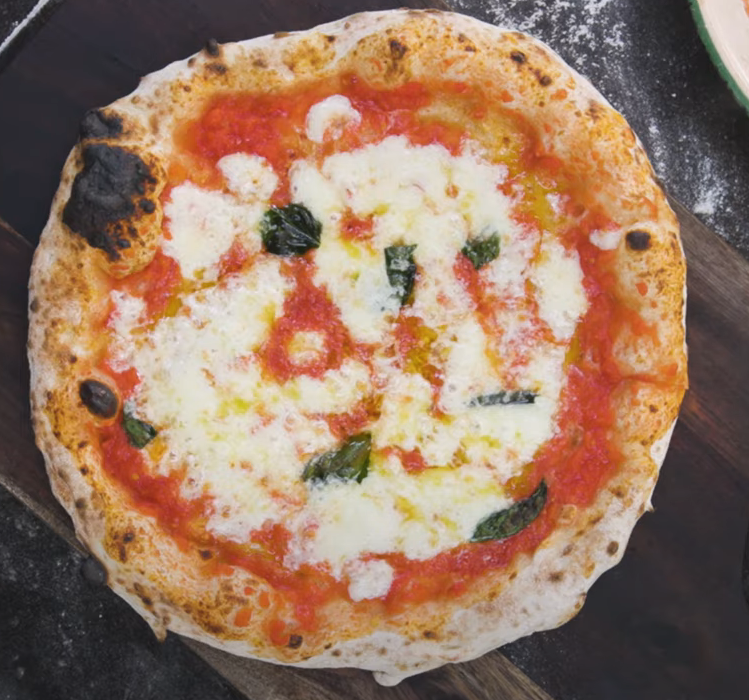
There was certainly a discernible difference in the taste/flavor of the pizza too. It had a subtle, smokey tang that made it tastier than the Neapolitan pizza we cooked with gas and it smelled amazing too.
Sadly, that was the only good pizza we made because from there, all we got were bad results. In our second pizza (pepperoni), for instance, the crust burnt before the middle cooked all the way – it’s like we let the oven overheat too much which wasn’t the case as it never went past 800°F.
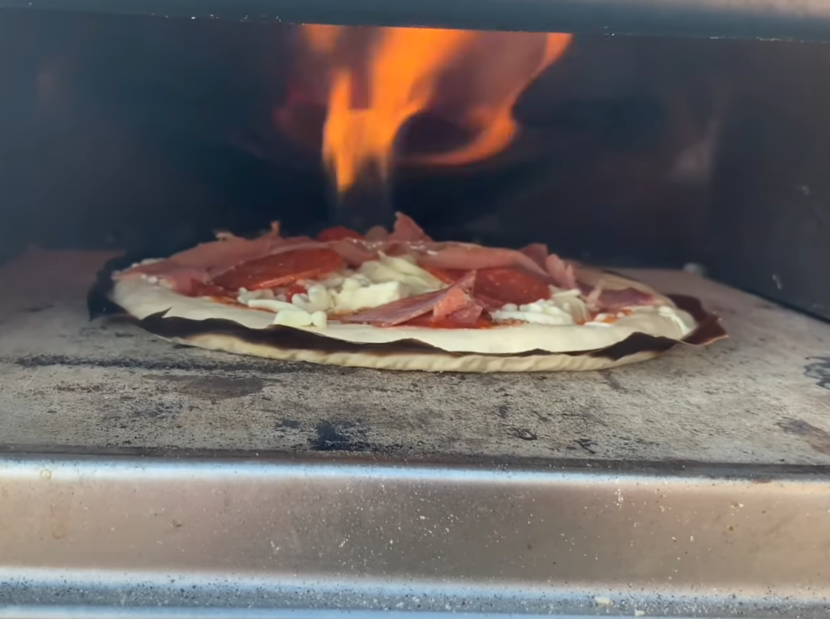
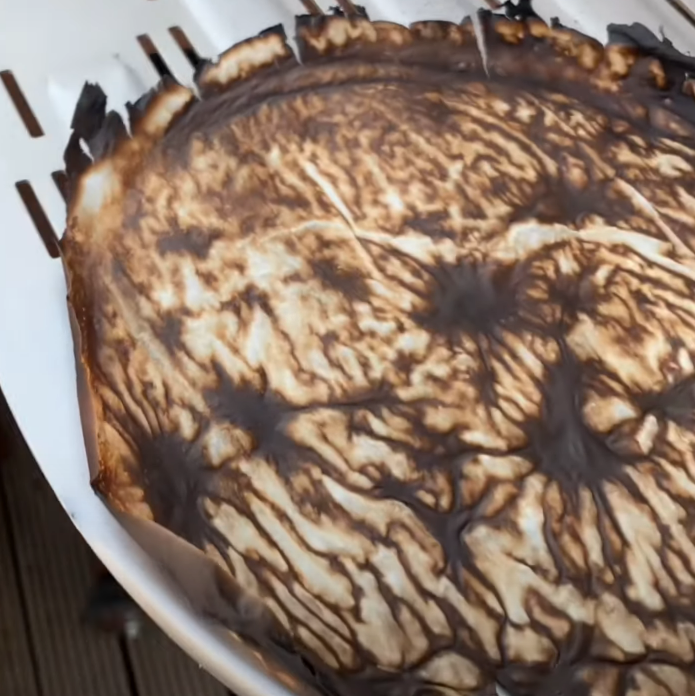
We gave it another try and this round, the bottom and edges of the crust were not crispy. The pizza was still very doughy, hence not thoroughly cooked.
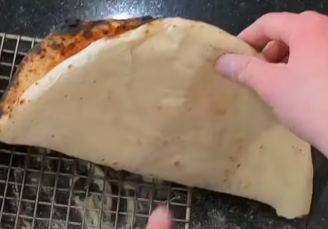
We got the same result with the subsequent pizzas we made. It was like the pizza stone had the heat consistently sucked from it. Even after letting the Roccbox re-heat, we still couldn’t get a crispy base. We tried making the dough a little bit thinner but we got the same result. We were really having trouble getting the pizza cooked all through without them getting burned.
The only other time we had success again was when we fired up the oven during our second time testing with wood. The first pizza we cooked, which was pepperoni pizza, turned out fine with the crust crispy and cooked all through from the center to the outer edges.
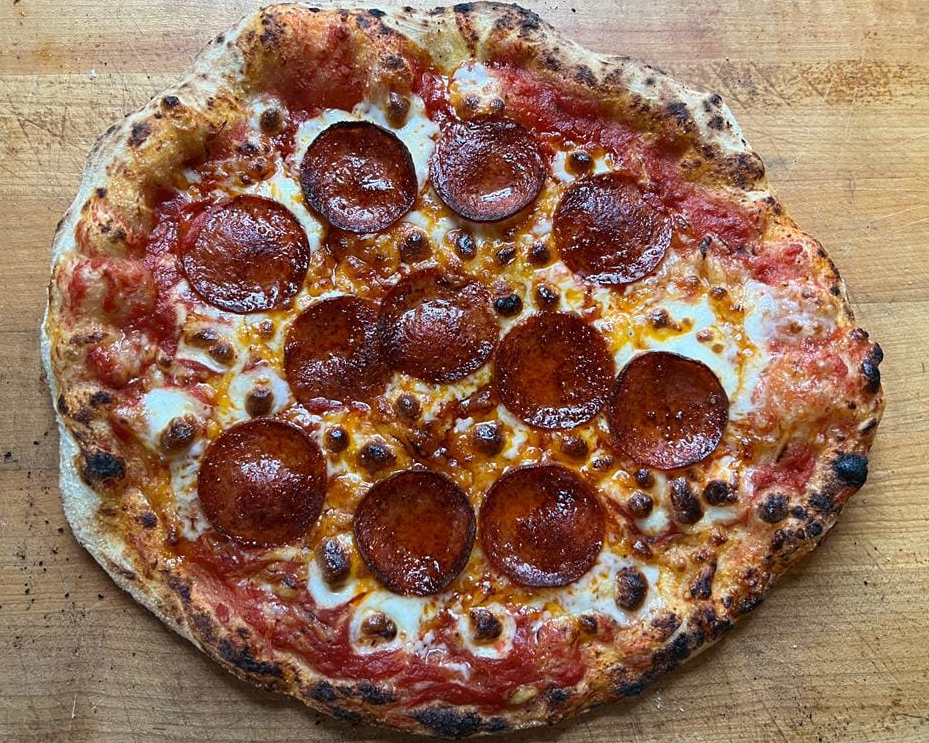
The second pizza was okay but from there, it was back to the same problem.
Generally, cooking with wood on this Roccbox is a long learning experience that our short time testing it couldn’t afford us. Except for the two pizzas that turned out okay, the rest were just doughy with burnt bases and tops. We just had to resort to gas throughout our remaining tests.
Even with gas, though, you still have to very actively watch each pizza so that you can rotate them on time to ensure even cooking. The edge closest to the back cooks and chars more quickly, hence it can burn easily if you aren’t quick enough to turn the pizza.
You’ll definitely need a smaller peel to be able to do that. The included pizza peel is nonstick but too large hence hard to quickly turn pizza with – you have to get the pizza out to turn it. it’s only good for launching and removing the pizzas.
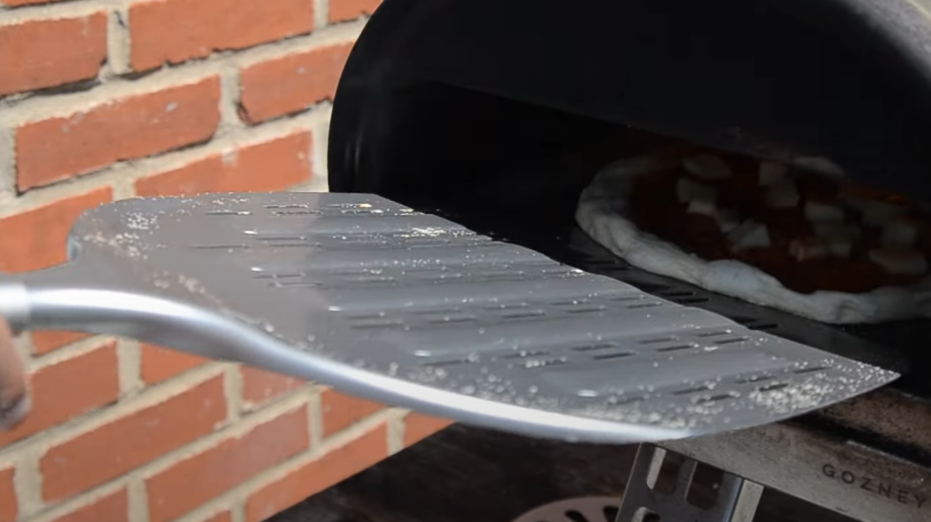
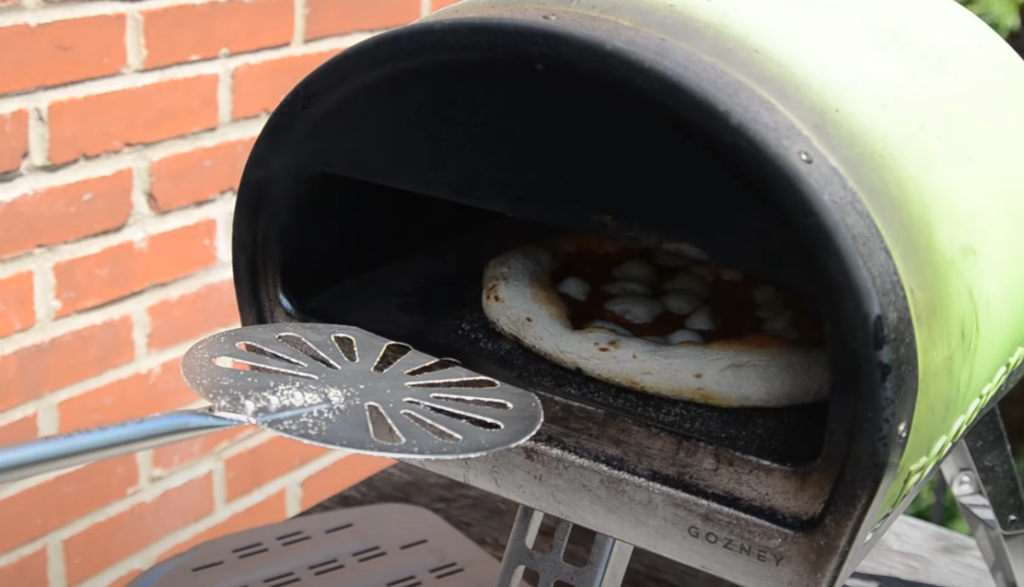
We also found that lowering the flame and the heat a little (to medium-low) before launching the pizza does help reduce the chances of the crust burning. The heat is usually intense if you leave the oven running full flame after it has heated up. So, it can end up quickly burning the toppings and the outer edges closest to the back once you put in the pizza. After turning the pizza the first time, you can turn the flame back to full again until the pizza is cooked evenly.
Our Score: 8.5 out of 10
Cooking Time
Gozney claims that the Roccbox can cook pizzas in 60 seconds on gas. For sure it retains heat well enough to cook pizza after pizza but in our testing, we found that they overstated the time a little bit. Even the fast-cooking Neapolitan-style pizza took about 90 seconds to cook perfectly.
Most of the other regular pizzas were done in around 2 minutes with the heat slightly turned down. We checked them after the said 60 seconds and often found the base was indeed cooked but looked pale – when we cooked them for another minute, the base was nicely blistered.
However, other pizzas we made like Margherita took less than two minutes to cook due to their slightly thin dough. So, the thickness of the dough may affect how fast your pizzas will cook.
As for turning the pizzas, we rotated them at most 4 times, that is, after about every 25-30 seconds. For instance, we rotated the Neapolitan pizza 3 times, after every 30 seconds until it was done. You have to have the timing right because you can easily watch your pizza burn if you fail to turn it quickly enough. However, if you get your timing correct, you can rip through 20 pizzas in an hour or so with gas.
When we used wood, the two pizzas that we were able to cook successfully took around 3 minutes each. The rest ended up burned yet undercooked within the same amount of time.

Gozney Roccbox
Cooking Space
The Roccbox’s cooking space is fairly large, measuring around 12.2 x 13.4 x 7.5 inches. It can accommodate a 12-inch pizza but there’s very little room left around the edges which makes adjusting the pizza while in the oven a bit hard. Most of the pizzas we made were 10 to 11 inches in diameter which made them easier to turn using the small peel.
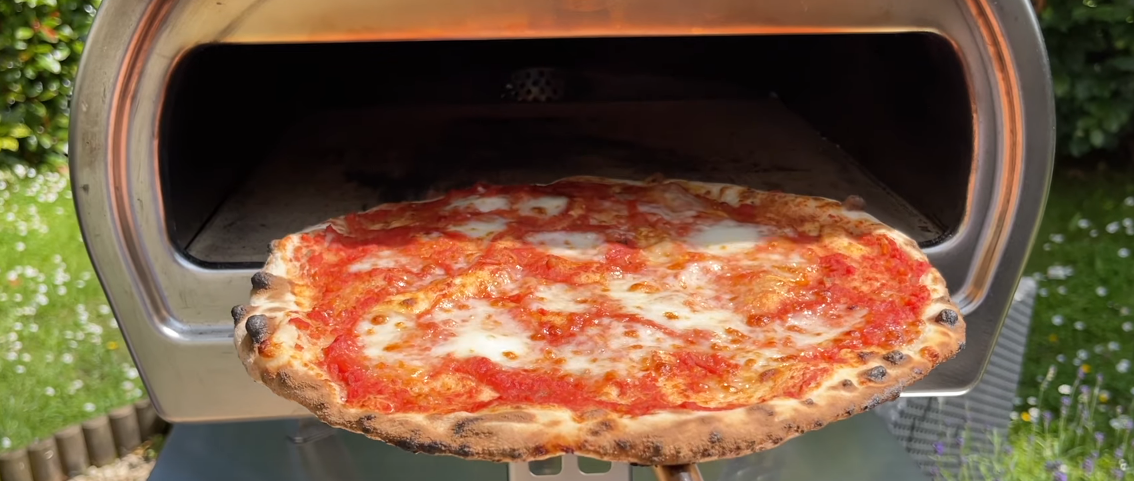
The opening/mouth of the pizza on the front is moon-shaped and although it’s a bit shallow (around 3.3 inches tall), you get to see the pizza cooking, plus the tall legs positioned the dome sufficiently high that you don’t bend down much when looking inside the oven.
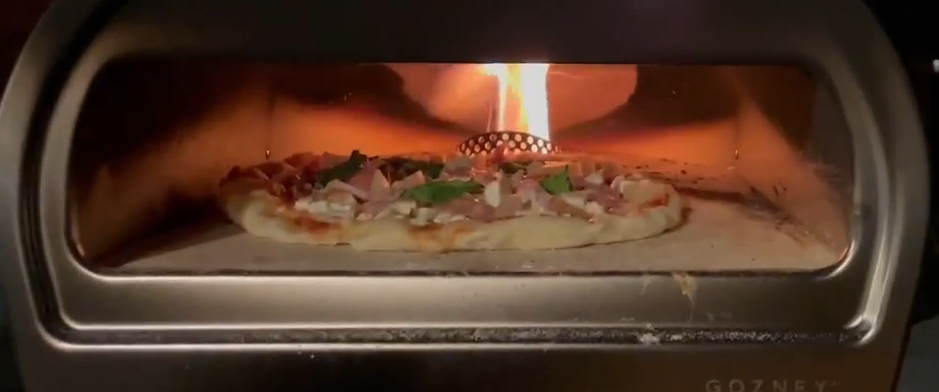
The height of the dome is decent enough to accommodate a medium-sized baking tray or shallow cast iron pan. So, you can utilize the high, consistent heat of the oven when using gas to bake, sear, or grill other foods like fish, buffalo chicken wings, steak, or clams. We didn’t try out any of these but the intense dry heat and rolling flame provided by the gas burner is enough to beautifully char steaks/fish and produce crispy, crackling skin.
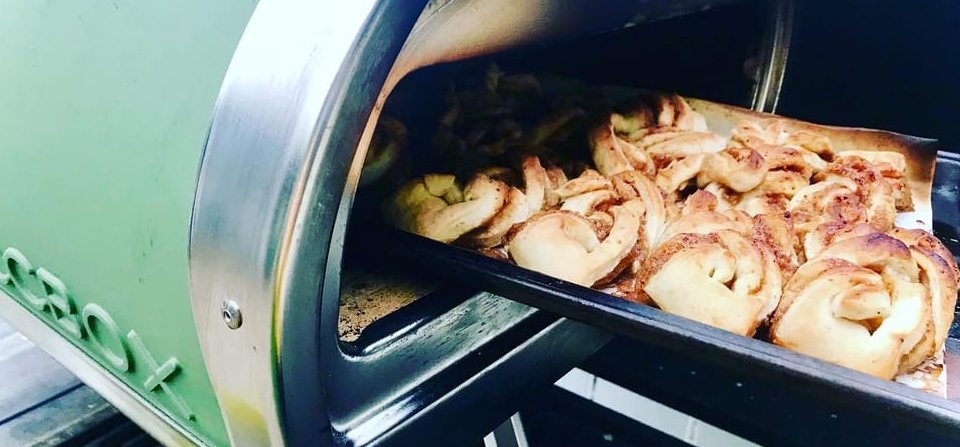
We also found that lowering the flame and the heat a little (to medium-low) before launching the pizza does help reduce the chances of the crust burning. The heat is usually intense if you leave the oven running full flame after it has heated up. So, it can end up quickly burning the toppings and the outer edges closest to the back once you put in the pizza. After turning the pizza the first time, you can turn the flame back to full again until the pizza is cooked evenly.
Our Score: 8 out of 10
Cleaning
Cleaning the Roccbox was a bit tricky. Anything that drops from the pizza ends up sticking to the cooking stone. It then dries, ignites, and burns right onto the stone. Getting out all these burned-up cruds takes a bit of work as you can’t remove the stone from the oven, plus the oven’s opening itself is too narrow to put a hand in there with a scrubber.
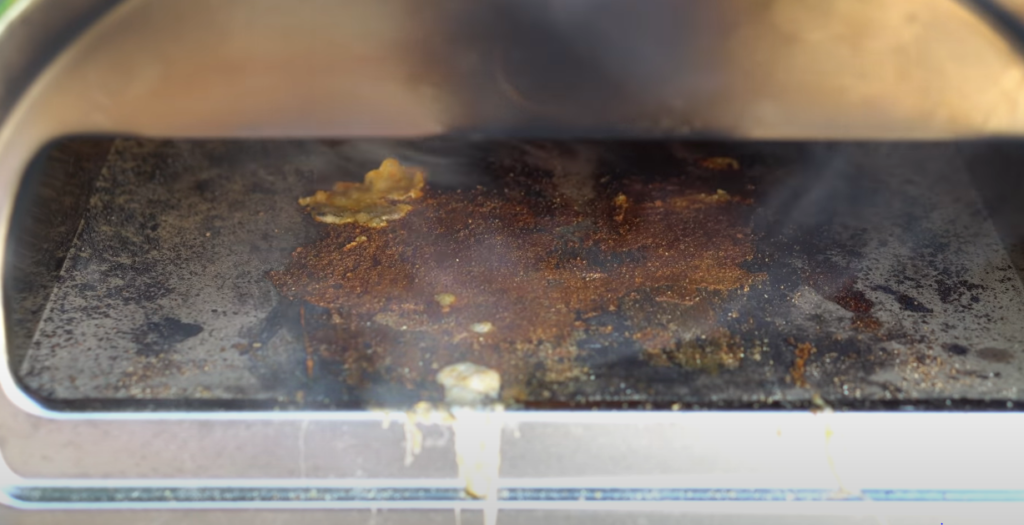
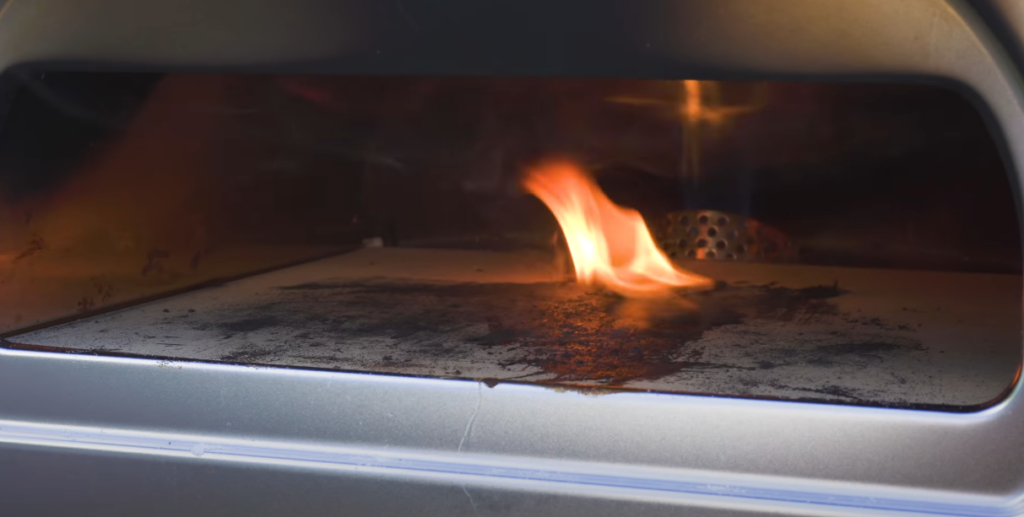
The only solution is to let the oven run on full flame for about 30 minutes when you’re done cooking. This gets it red hot to incinerate any residue or food leftovers burned onto the stone. You have to then let the stone and oven cool down to get rid of what’s left of the incinerated remains. That can take a while because the stone retains the heat for a long time. We had to wait up to two hours for it to fully cool down after firing up the oven to maximum temperature.
Once the oven cools down completely, you can use a bristle brush to sweep the leftover ash toward the sides – stuck-on bits may need a nudge with a scrape to loosen them. From there, you can vacuum out the ash or tilt the oven to the front for the ash to fall out of the opening.
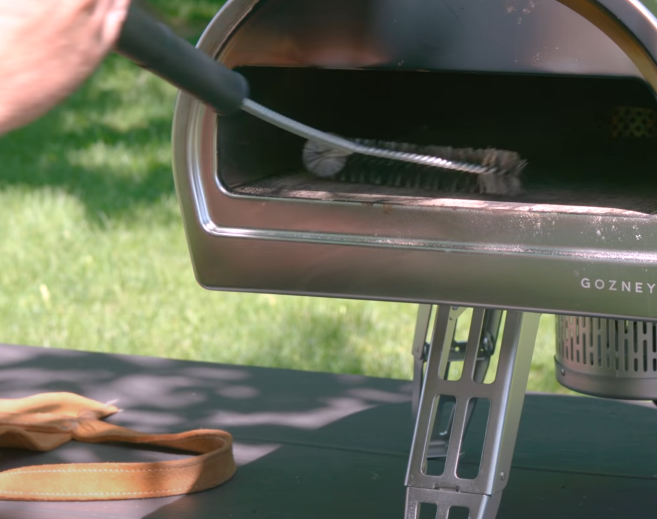
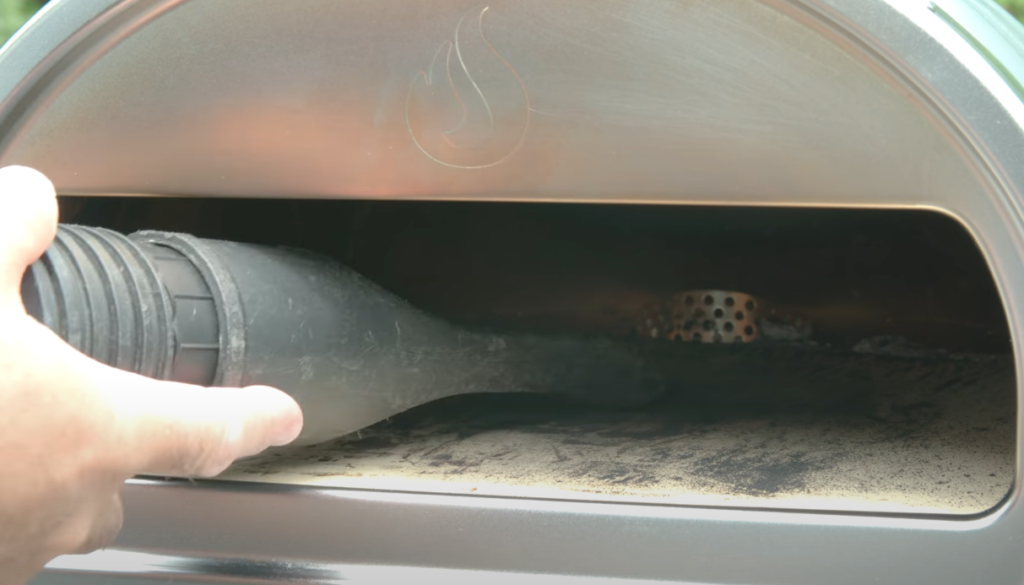
The stone never again looks as clean as it was, even after cleaning. It gets cooking marks and becomes discolored too but that’s expected of any pizza stone.
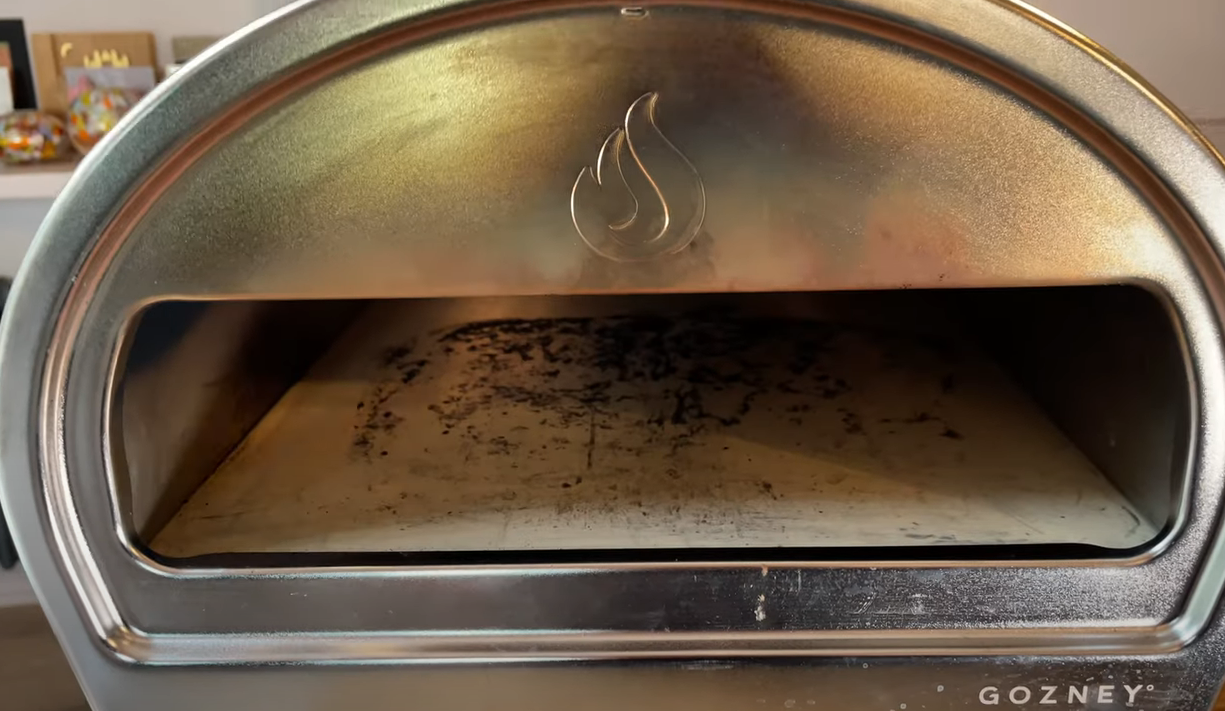
The interior and exterior of the oven also require cleaning. The metal section on the front gets sooty after each use, even with gas. The interior, especially the top gathers soot as well. This is normal but getting covered in soot inside and outside every time you cook really isn’t much fun.
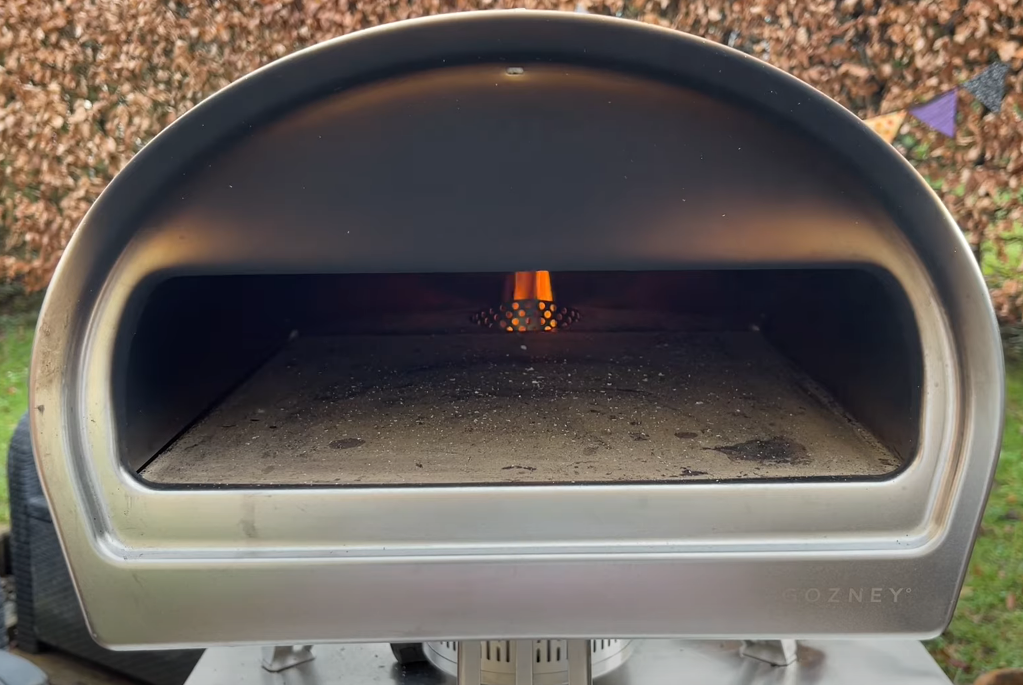
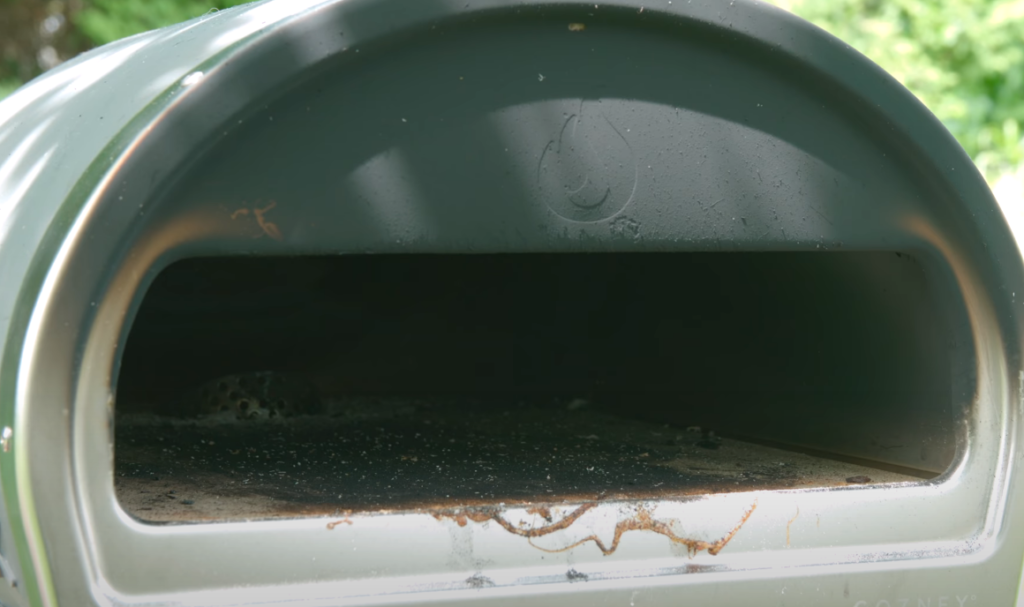
When you use wood, the soot also builds up on the burner and if it’s windy outside, soot, and even some ash can settle on the oven’s body. All these make cleanup tiring.
The soot in the interior does clean off fairly easily, though, when using a damp paper towel. For the front part, a damp paper towel can work but we found using a Bar Keeper’s Friend too is much better. It cleans it right up, completely removing the soot and dark stains.
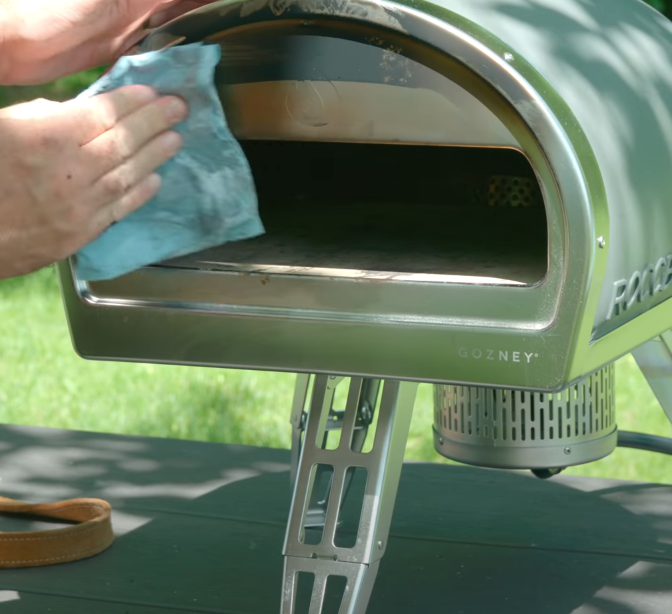
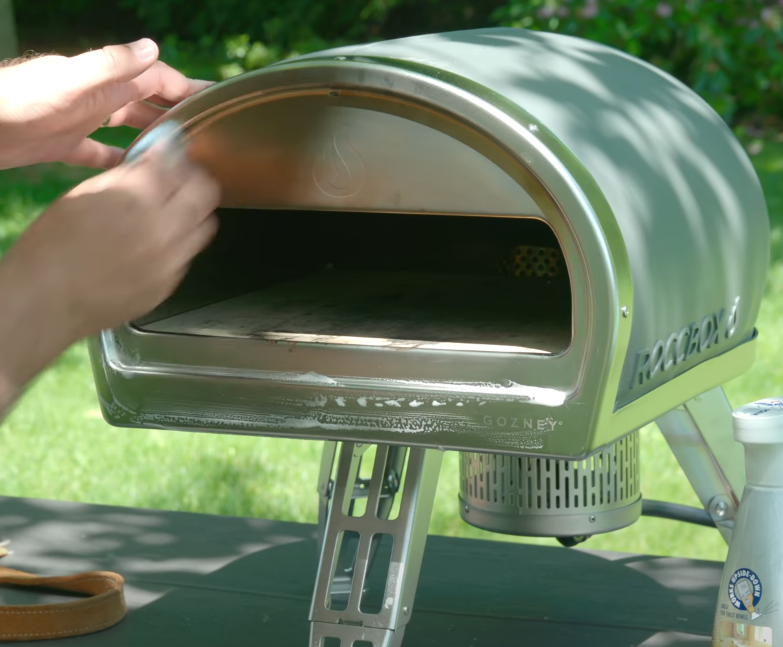
The only annoying thing is that the soot builds up every time you cook which makes it a pain to clean. We only cleaned it all off when we were done testing the oven. Plus, the metal at the front develops a slightly bronze patina due to the heat. It doesn’t retain its beautiful shine even after cleaning.
Fibers also get easily attached to the safe-touch silicone jacket and it can stain badly, but it does clean up well with a damp non-abrasive cloth. The gas burner is simple to clean. You just clean around the top part where the flames come off using a brush.
We didn’t find the wood burner hard to clean too as all the ash remains in one place, so it’s simple to empty considering that the burner clips right under the oven. The downside is that you have to dispose of the ash quite often if you’re cooking a couple of pizzas. The wood burns rapidly and the remaining coals fill up the hopper quickly. So, you have to clear them several times to be able to add more wood to keep the fire going.
Our Score: 7 out of 10
Other Highlights
The dual-fuel capability was certainly one of this Roccbox oven’s major selling points. Igniting it when using the gas burner was pretty simple as we just had to push in the knob on the burner and turn it counterclockwise. The burner has a built-in ignitor that ignites immediately and from there, you just adjust the flame and wait for the oven to heat up. It’s that easy, plus the knob makes controlling the heat level and the flames’ intensity easier.
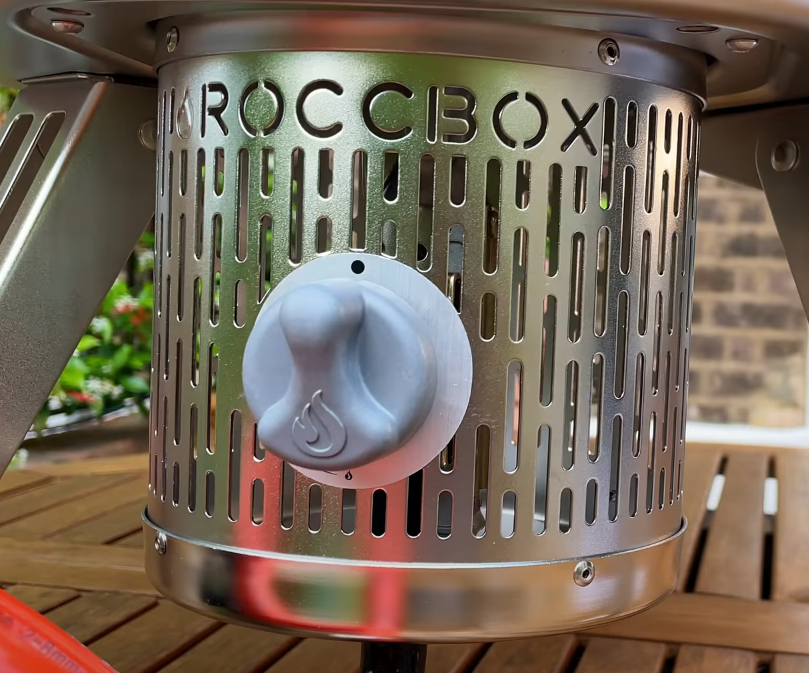
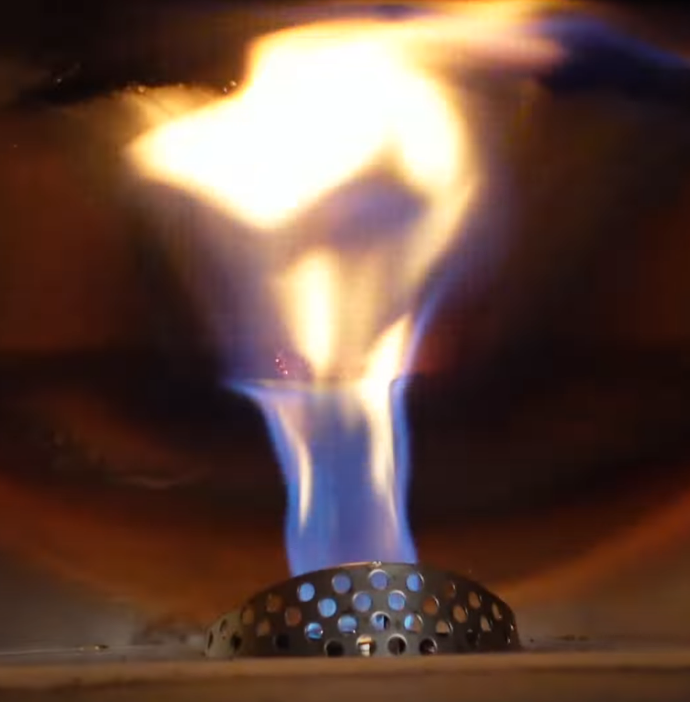
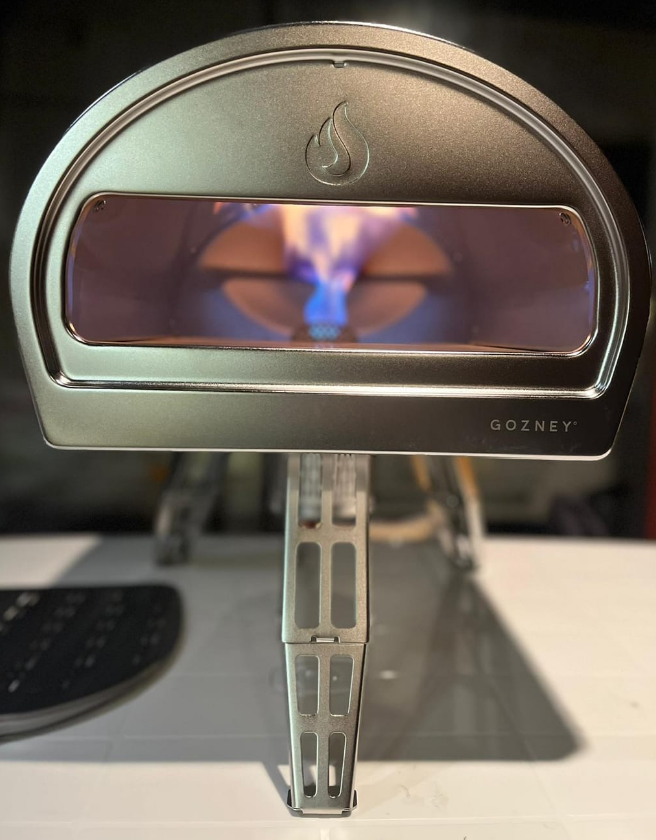
The Roccbox can only be used with either propane (LPG) or butane. It certainly can’t use natural gas. The burner attaches with just one fitting and a 1m-long hose. A Propane regulator is provided as standard. It can be fitted to a 20lb or even 5lb tank size valve. We fitted ours to a 20lb propane tank that we normally use for our grill.
We tested the oven with the gas burner for a whole week and we hardly put a dent in the 20lb of propane we had. We started with a full tank and made at least 25 pizzas and the tank was still feeling full, despite the fact that it took roughly 45 minutes to heat up every time we fire it up. So, we can certainly say the Gozney is fairly fuel-efficient with gas usage.
However, getting the oven fired up and running with wood takes a little bit more work and can sometimes even be tricky if you don’t use the right type of wood. You have to load small pieces of wood onto the hopper first and light them using a small butane firestarter/a blow torch.
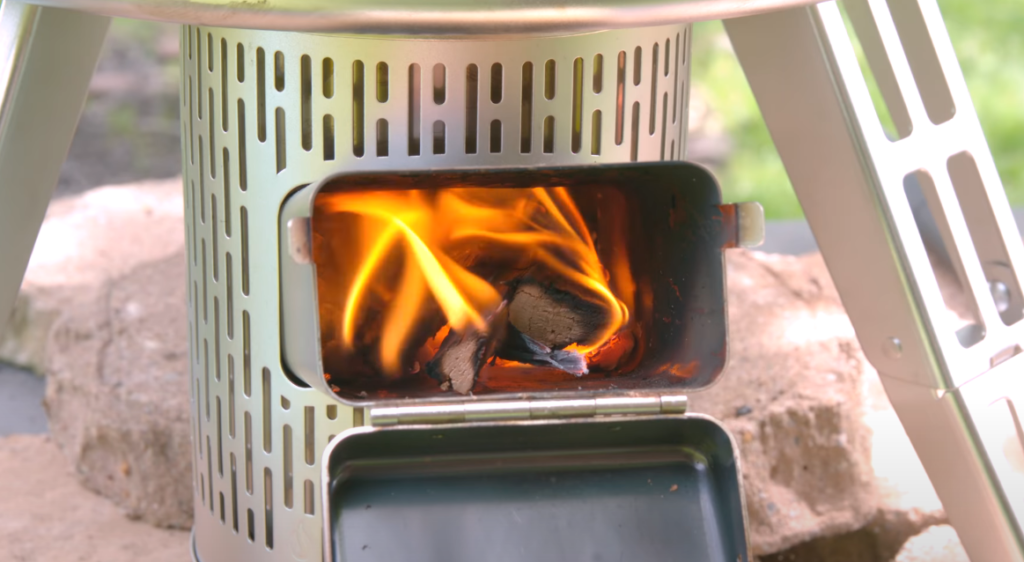
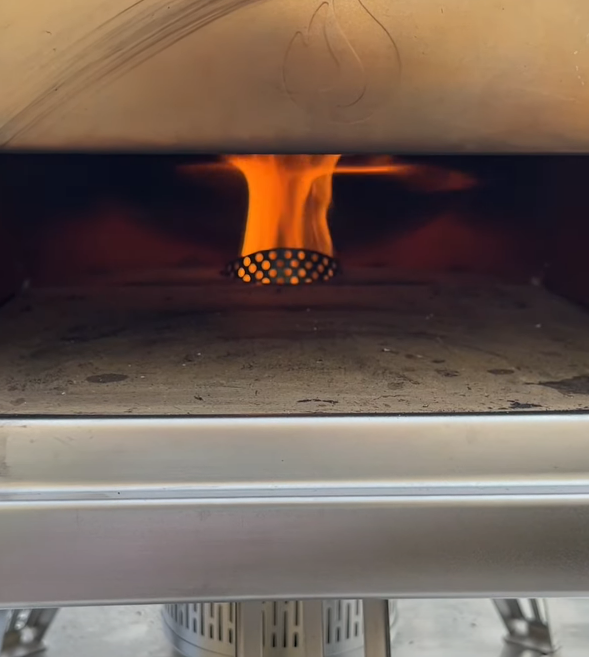
Once they’re fully lit, you push the hopper into the burner’s fire chamber and then add a few more pieces of wood (two or three) and let them burn. When the flame starts coming out right at the back end of the oven, you now keep adding more pieces of wood (after about every 10 minutes) to raise the oven’s temperature and flame’s intensity.
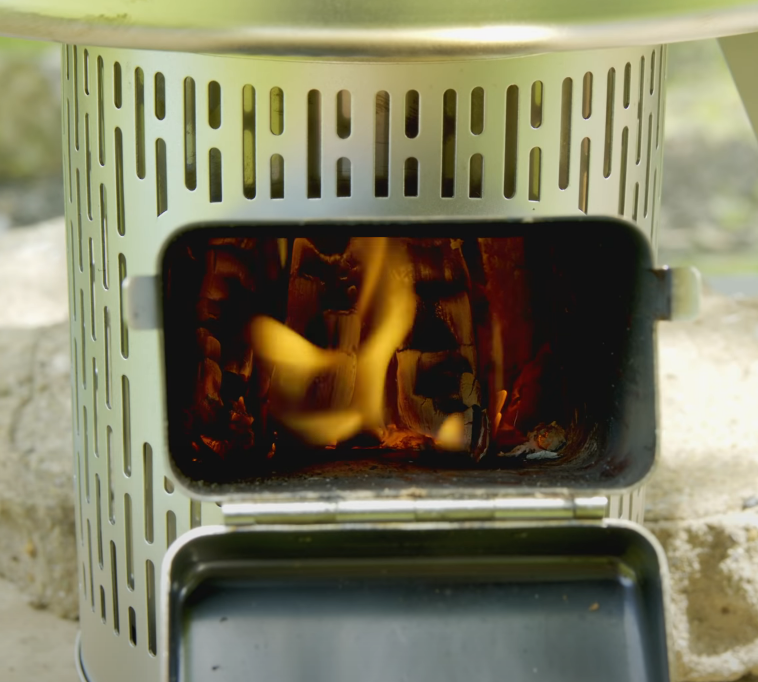
It’s more work and once the oven heats up, you still need to feed the burner wood constantly to rekindle the fire and keep the flame rolling strong. Otherwise, the flame’s intensity reduces and the oven’s temp drops significantly as you continue using it.
You have to use hard, kiln-dried, non-treated wood such as oak, beech, ash, and fruit trees like pear, apple, etc. Compressed wood briquettes can work too. Redwood, pine, cedar, fir, spruce, and other soft or sappy wood are not recommended. You can’t also use recently cut wood or recycled wood used for pallets or furniture, or stained or painted wood.
The hopper of the wood burner itself is a small cylinder – the opening is around 3 by 2 inches. Gozney recommends that the wood should be cut into very small pieces, about an inch thick and 5 inches long. That’s almost the size of pencils, which we found to be a little impractical. Even if you get a bag of regular kindling, you’ll have to cut them down to fit them into the small hopper which is cumbersome and time-consuming.
While wood is cheaper than gas, the Roccboz was nowhere near fuel efficiency when using wood. It used lots of kindling for only a short period of cooking. The small wood burner burns through wood rapidly hence requiring constant top-ups (almost after every 5 to 10 minutes).
So, while we liked having the option of cooking with gas or wood, gas was no doubt the clear winner with regard to speed, heat, and temperature control.
When it comes to extra features and accessories, the built-in thermometer is one nice little touch that we liked as it was quite functional. Unlike other ovens with built-in thermometers, the thermocouple of this one is set underneath the stone floor to prevent false temperature readings. We measured the stone temp of the Roccbox using our infrared thermometer and the results were consistent with what the built-in thermometer was reading.
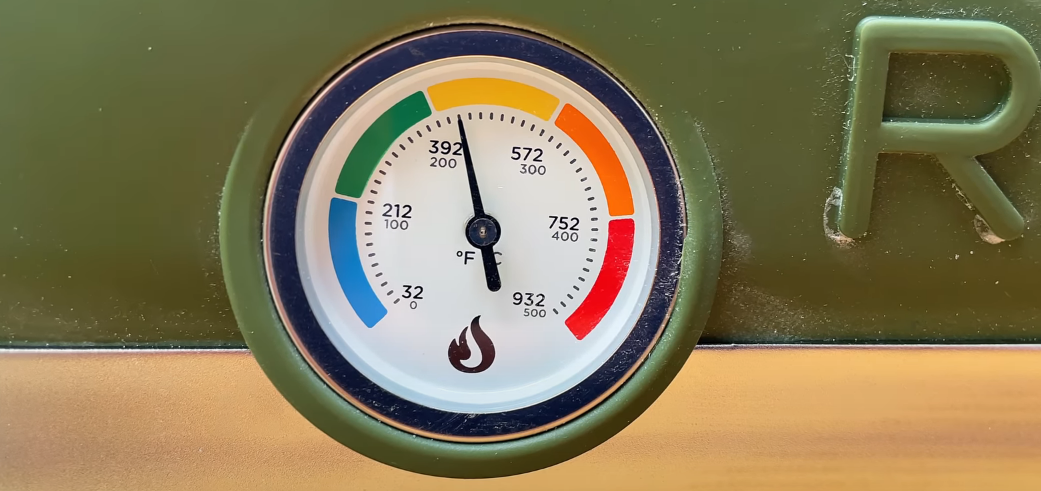
The only setback is that it’s an analog thermometer. It has color palettes for indicating different temperature zones for easy reading but it’s not really as precise as a digital alternative. We would suggest getting a quality infrared thermometer gun for faster and more precise readings.
Another feature we liked is the silicone cover on the exterior. It prevented the outside surface from getting as hot as inside the oven. It never got above 200°F (checked with our thermometer). Still, though, you don’t want kids or pets near the oven while it’s on because the front end cap and the burners attached to the back do get extremely hot.
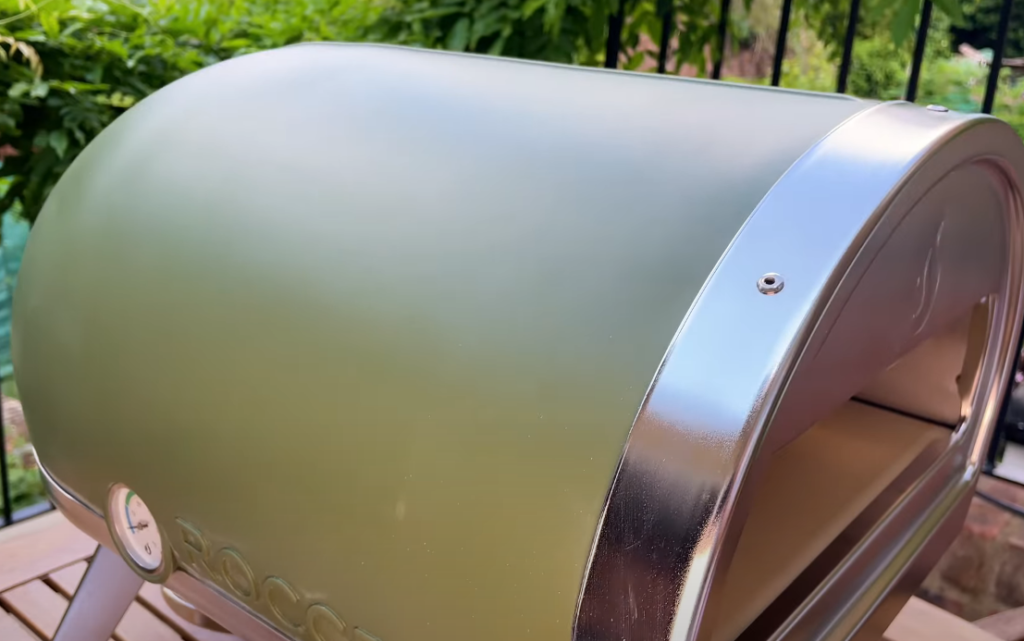
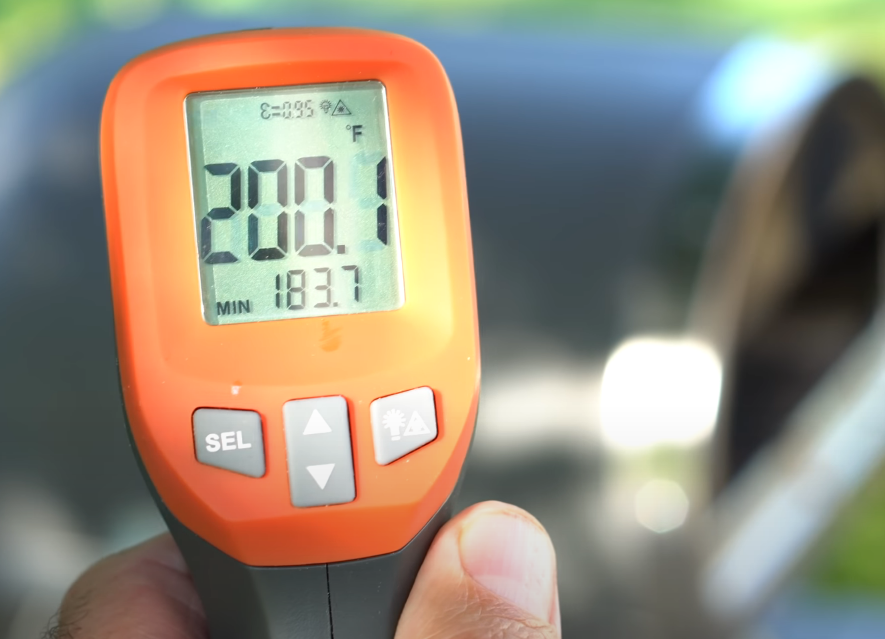
We liked too that the bottle opener that Gozney included doubles as a hook that allows you to safely open the door of the fire chamber – you don’t directly touch the hot handle.
The pizza peel was also a good addition but it was hard to turn pizzas with it while in the oven due to its large size. Besides that, while it’s nonstick, we found its holes a little annoying as they spilled flour on the counter or floor which made cooking and cleaning messier than necessary.
The only accessory you need to get is a cover. You can leave the oven outside but you have to cover it to keep it away from the elements.

Gozney Roccbox
Final Remarks
Cooking with the Gozney Roccbox oven was an absolute joy, particularly when using gas. It stayed hot throughout such that we were able to cook pizzas back to back and the results were amazing right from the first pizza – we never had burned toppings or undercooked crust.
The wood was a pain to use. It takes longer to heat up and there’s a lot of work involved to get the oven hot and keep the flame going yet still the heat is often not consistent. The preheat time with gas is still fairly long but the oven performed way better than when using wood.
Overall, the Roccbox is a very capable pizza oven, especially if cooking with gas. We appreciated the little but functional design details and accessories it offered along with the option to choose between two colors. It isn’t the cheapest or the lightest option on the market but it’s certainly worth the cost. Plus, there’s not much assembly needed. It’s almost ready to go out of the box.

